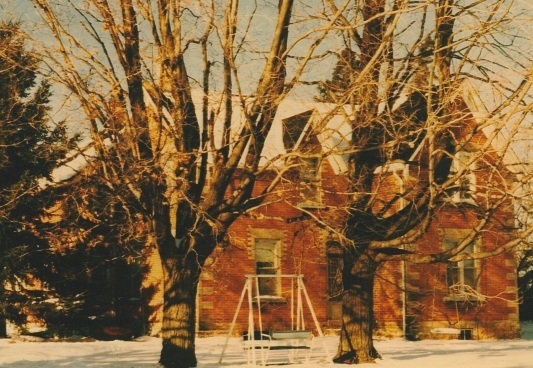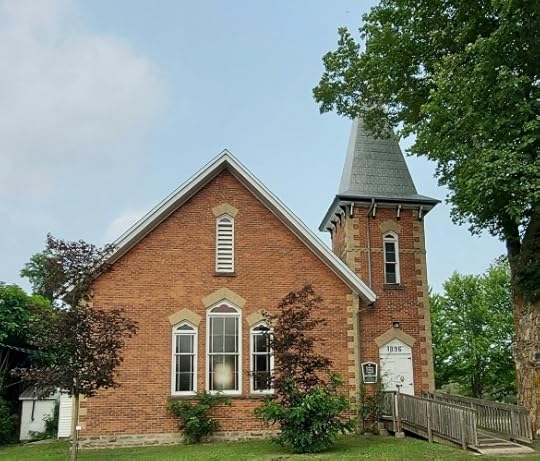Arlene Stafford-Wilson's Blog, page 11
March 13, 2024
Irish Wakes
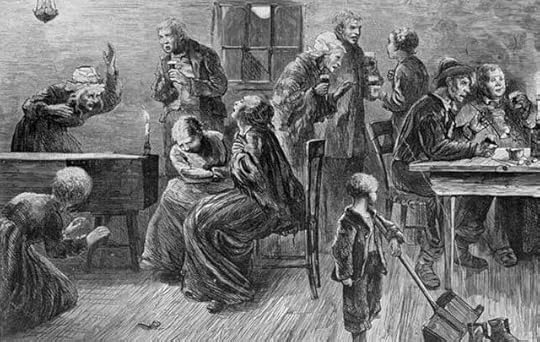 Depiction of an Irish wake – 1873
Depiction of an Irish wake – 1873Traditions of the Irish Wake
“The terrible thing about dying is
that you miss your own wake”
David Allen, Irish Comedian
Traditions seem to go on forever in small rural communities. They are passed down from father to son, and from mother to daughter. The tiny community of Ferguson Falls was settled by seven Irish bachelors and their story was told and re-told through the ages, so it wouldn’t be forgotten. When these young men landed from the old country in the early days they made a pledge to help each other to succeed in the new land, and if even one of them failed to thrive they would all return to Ireland. They were Patrick Quinn, John Quinn, James Carberry, William Scanlan, Terrence Doyle, John Cullen and James Power.
Around the same time my own ancestors arrived – the Stafford and the McGarry families, from County Wexford and County Westmeath, and the Irish-Catholic community grew and prospered in this idyllic community along the Mississippi River in Drummond Township.
In those days it was unusual and even frowned-upon to marry outside of one’s religion, and so the traditions and customs brought from the old country remained firmly entrenched in these early settlers and their families and were passed down for generations. It’s not surprising that many of these practices were still taking place in the 20th century, some with pagan Celtic origins, some more religious, and some so ancient they could no longer be explained.
As a young girl I heard stories, mostly from my father, who grew up near Ferguson Falls, and also some vivid tales from some of the old timers in the area. Some of their most colourful accounts included stories about their Irish wakes.
I remember my father telling me about his uncle’s wake, held in the family home, as was the custom. He said that the wakes were another excuse for people to get drunk, maybe a little drunker than usual, and they did some things that were almost unspeakable. He recalled his deceased relative being ‘laid out’ on the dining room table and that late at night two of the intoxicated guests attempted to pour whiskey down the dead man’s throat.
Many years ago, I also heard from one of the old-timers, James ‘Jim’ Quinn, a direct descendant of one of the seven Irish bachelors, that the standard rate to dig a grave was a bottle of whiskey. The usual amount was twenty-six ounces and was split between two men, who dug the graves by hand at St. Patrick’s cemetery. He was, in fact, according to him, one of the two who dug the grave for my great uncle Jimmy Richards, and the lads were paid in the usual way, a bottle of whiskey, from my great aunt Tessie Richards, the departed’s sister.
The ‘Third Birthday’
The eldest ones used to refer to death as ‘the third birthday’. They claimed that the first birthday was the day you were born, and the second birthday was your baptism. The third birthday is the day you pass away, and should be filled with both mourning and celebration as you move from this life and enter Heaven.
Stop the Clocks

All clocks in the house are stopped at the hour of the death as a sign that the passage of time has ended for the departed. Time stands still for them, and a new period of existence begins, without time. It was believed that if time continued to move ahead that this invited their spirit to remain in the home rather than moving on. Some say it was also a way to mark the time of death. Others claimed it is done so mourners will stay as long as they please without worrying about the time.
The Open Window
Immediately after the death, the window closest to the deceased is opened for two hours. The open window allows the spirit to leave the body. No one must stand near nor block the path to the window as it might prevent the spirit from leaving, and will bring misfortune to any person who blocks it. After two hours have passed the window is closed so that the spirit doesn’t attempt to re-enter the body.

Close the Curtains
With the exception of the open window closest to the deceased, all other windows are to be closed, and the curtains should be drawn until the body is removed from the home for burial. It was thought that if a moonbeam shone through a window at night that evil spirits could come in and try to steal the deceased’s soul.
Photographs Turned Face-Down
Family photographs were turned face-down so that the people in the pictures would not be spirited away with the deceased.
Cover the Mirrors
All of the mirrors in the home were either covered with cloths, or turned backward, facing the walls. There were two reasons behind this custom – that the deceased’s spirit doesn’t see their physical body in the mirror as they leave the home, and so that their spirit doesn’t get trapped inside the looking glass.
Mourning Cards
In the old days people kept black-bordered funeral stationary in their homes. Shortly after the death occurred, they wrote an announcement by hand, on a full sheet, enclosed it in black-bordered envelope and pinned the notice with a thumb-tack to the outside door. A black ribbon was also hung on the door. Neighbours could stop and read the announcement and learn of the date and times of the wake and funeral. A note at the bottom of the page encouraged neighbours to spread the news. A call was placed to local printers to order formal funeral cards, which included information about the deceased, and sometimes a photo or a prayer. The Mourning cards were also known as Prayer cards or Holy cards. Local newspapers were called and orders for obituaries were placed. The Mourning cards were available at the wake and at the funeral and given as a keepsake for the mourner to bring home with them.

Traditional Mourning stationery
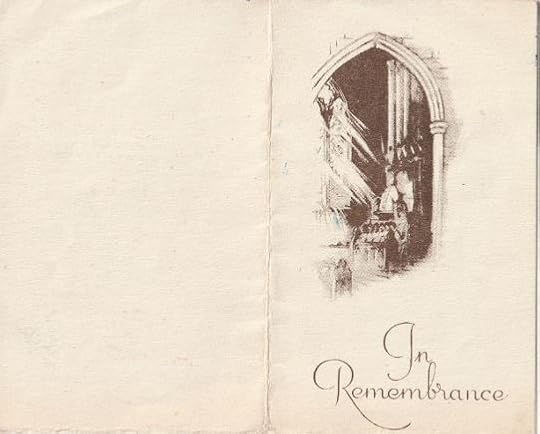
Mourning card – Anastasia ‘Stacy’ Richards Stafford (my grandmother) 1954
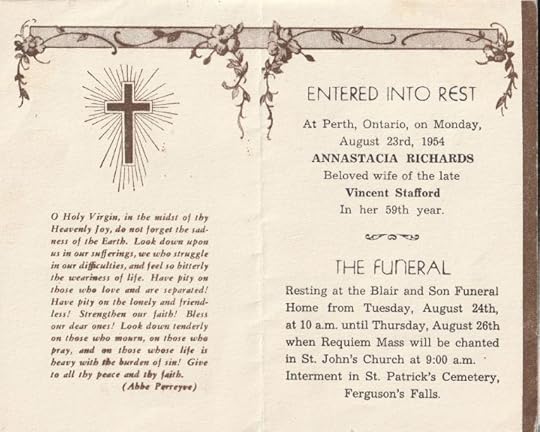
Anastasia ‘Stacy’ Richards Stafford – Mourning card – 1954
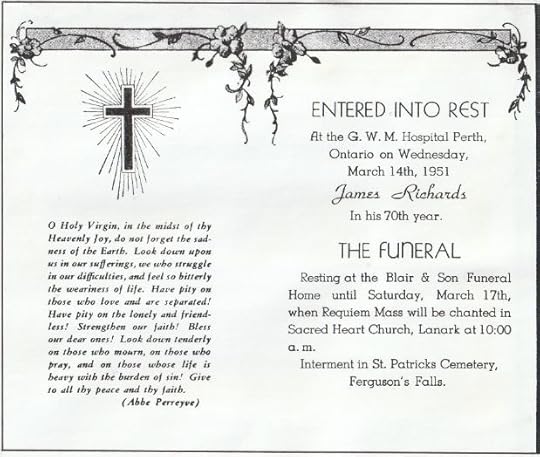
James ‘Jimmy’ Richards – Mourning card – 1951 (Jimmy, my great-uncle, was a farmer in Ferguson Falls and well-known local musician who played his fiddle regularly at the infamous Stumble Inn along the Mississippi River at Ferguson Falls)
Preparation
The body of the deceased was washed with Holy water, and dressed in their best clothing. There were often older women in the community who performed this task for the families, and were offered whiskey or food as payment and thanks. Men were shaved and both men and women had their hair combed and arranged nicely. Conservative dress was expected for the deceased and bright or pastel colours were not considered appropriate. The bodies were laid out on top of white sheets, usually on a long flat surface, such a dining room table. In Catholic homes rosary beads would be wound around the hand, with the crucifix laying on the person’s chest, close to their hearts. Once the body was prepared the deceased was never left alone in the room. At least one person must remain, and usually there were groups of people who remained awake through the night with the dearly departed. This custom of remaining awake is the origin of the term ‘wake’.
Candles
In some families white candles were placed all around the table where the deceased was laid out, however some families used only 4 candles placed around each of the four corners of the table. Candles were to remain lit (replaced as needed) until the body left for the funeral. It was bad luck to let one of the candles burn out and they were replaced as they burned down close to the end of the wick. The candles used at wakes were said to have healing powers, and the butts of the used candles would be saved and rubbed on burns and cuts.

Keening
Keening comes from the Gaelic word meaning ‘to cry’. Women from the neighbourhood would gather at the wake and sob. There were even professional keeners who could be hired to cry at wakes. The art of keening originates from the Irish Banshees who shrieked and screamed foretelling a death. It’s been said that every family of Irish origin has their own Banshee, and that they even traveled with families across the ocean to the new world.
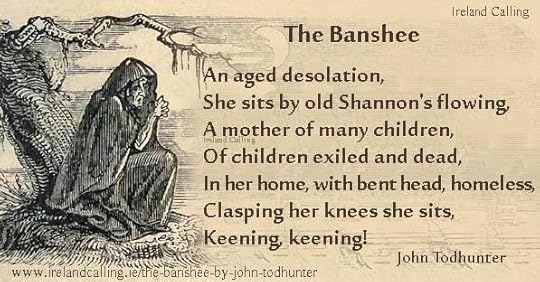
John Todhunter, Ireland Calling
What to Expect
If you’re planning to attend an Irish wake, then be sure to bring a little something for the family. Food, flowers or something to drink is always welcome, and a bottle of good spirits is always appreciated.
Although there is no dress code, wearing black or somber colours is a sign of respect to the family.
After a brief viewing of the deceased, you may pay your respects to the family with a few words, like: “Sorry for your troubles.”, or “Sorry for your loss.” It is a stressful time, and it’s not as important what you say, but more that you showed respect by attending.
The time you spend at the wake can be brief, as little as fifteen or twenty minutes, if you didn’t know the deceased very well. The busiest time will be the evenings, after suppertime, between 5 p.m. and 8 p.m. Neighbours, good friends and family members will remain at the wake for four to five hours, and the closest will stay all night, at least one night, in the room where the deceased is laid out.
The Food and Drink
After the wailing is over, the more social aspects of the wake begin. Food and drink for visitors are provided by the family, and it is customary for guests to bring a bottle of spirits, or some food for the wake. Shepherd’s Pie, Irish Stew, Corned Beef and Cabbage, cold cuts, and small sandwiches are common at wakes. Tea is served in fine china cups, and whiskey, beer, and wine are the most popular drinks, although any spirits will do.
Raise a Glass
It’s customary during the wake to raise your glass and toast the deceased. You might begin the toast by telling a little story about your friendship, or something amusing that happened, that the two of you shared. Some of the most popular Irish toasts at a wake: “May he rest in peace.”, “Gone, but not forgotten.”, “No one spread more love in a lifetime.”, “To absent friends.”, “To our friend who has gone on before us.”
The Smoking of the Pipe
A long-standing tradition is the custom of smoking from clay pipes. These small pipes were filled with tobacco for visitors to the wake house to take. Visitors lit the pipe and took a draw, exclaiming “Lord have mercy on their soul”. Non-smokers were also expected to partake of the ritual and in some cases snuff was also taken. After the funeral, the family broke the wake-pipes in two and buried them outside.
The Story-telling
It wouldn’t be a proper Irish wake without telling stories or reciting poems about the dearly departed. Fond memories are shared and become more animated and exaggerated as the whiskey flows throughout the days and evenings. There are stories of the school years from former classmates, and stories of the departed’s years of work, and about their trade or profession. Family stories and memories are shared with guests, with highlights of a life well-lived, and special anecdotes of their days on the Earth. Fiddles and flutes are played and songs are sung, jigs are danced, and stories continue throughout the days and evenings.
At midnight, the Rosary is said, concluding with: “Pray for us now, and at the hour of our death.” The neighbours, friends, and other guests leave the home, with only those closest to the departed remaining.
Some family members and dearest friends will stay all night in the room with the deceased. The stories and the drinking will continue overnight, and a new group will relieve them in the morning so they can get some rest. It is usual to wake for two to three nights before the funeral. The reason for waking at least two nights goes back to the very old times, and was to allow time in case the person was merely unconscious.
The Funeral
On the third day of the wake, the body is placed in a coffin and carried out of the home, always feet first, in order to prevent the spirit from looking back and beckoning another member of the family to join them.
Once the departed has been carried from the home, the mirrors are uncovered, the curtains pulled back, and the photographs are displayed again.
Exactly six pallbearers carry the coffin, and there should be 6 handles on the casket, three on each side, in remembrance of the Holy Trinity: Father, Son, and Holy Ghost. It isn’t always the case these days, but that is the Irish tradition. It is also thought to be bad luck to go home the same route as the one used by the funeral procession.
The funeral is usually held in church, and after that everyone proceeds to the cemetery. A short graveside service will be conducted by the priest.
Rain is a Blessing

Rain the day of the funeral is a sign of a blessing, and if you hear a thunder-clap it means that the deceased has arrived in heaven.
After the funeral, everyone will be invited back to the house, to a bar, or community location for some food and drinks to toast to the deceased and honour their memory together for one last time.
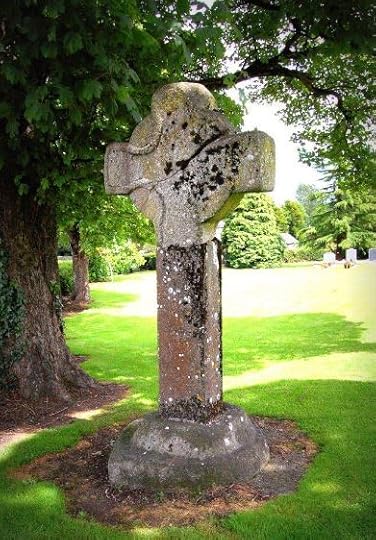
Many of the traditions of the Irish wake live on today, depending on where you live. Some customs have been adapted for modern times, and some of the old ways passed down through families, are strictly followed, as they were in days gone by.
“Grant them eternal rest, O Lord,
and may the souls of the faithful departed,
through the mercy of God, rest in peace.
Amen.”

St. Patrick’s Church, Ferguson Falls, Ontario, Canada, est. 1856.
“But since it fell into my lot
That I should rise and you should not
I’ll gently rise and softly call
Good night and joy be to you all
So fill to me the parting glass
And drink a health whate’er befalls
Then gently rise and softly call
Good night and joy be to you all.”
“The Parting Glass”, written by Trad / David Anthony Downes
Sources for “Irish Wakes”
Delaney, Mary Murray. Of Irish Ways. Dillon Press, Inc, 1973
Staffords Funerals, website, Dublin, Ireland
Bourke.A (1988), The Irish Lament and the Grieving Process, Women’s Studies International Forum, Vol.11, No.4
Danaher.K (1962), In Ireland Long Ago, Mercier Press.
Lysaght.P (1988), Caoineadh os Cionn Coirp: The Lament for the Dead in Ireland, Folklore 108.
About the Author:
Arlene Stafford-Wilson
Arlene Stafford-Wilson was raised on a small farm in Bathurst (Tay Valley) Township. Her Stafford and McGarry ancestors left southern Ireland, and arrived in Lanark County in 1816. She also descends from the McKittrick, Waters, Doyle, Carroll, and O’Keefe families, also from southern Ireland.
Honorary Life Member, Lanark County Genealogical Society
Lanark County Pioneer Families Humanitarian Award
Member, Association of Professional Genealogists
Author of : “Lanark County Kitchen”, “Lanark County Christmas”, “Lanark County Comfort”, “Lanark County Collection”, “Lanark County Calling”, “Lanark County Classics”, “Lanark County Connections”, “Lanark County Calendar”, “Lanark County Chronicle”, “Lanark County Kid”, & “Recipes & Recollections”
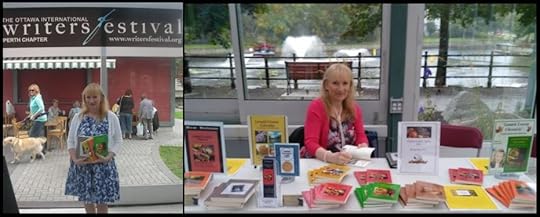 Arlene Stafford-Wilson
Arlene Stafford-Wilson*

.
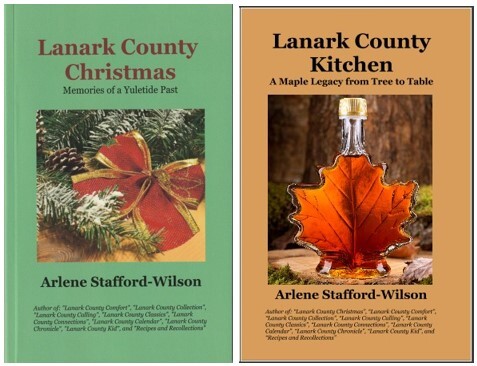
March 12, 2024
Irish Settlers & the Ghost of Burgess Township
The story of the Burgess Ghost begins with the arrival of so many Irish to the areas around Westport, the Scotch Line, Black Lake, and Stanleyville, that it became known as the ‘Irish Invasion’.
This is the the home where the story took place, in the cold, bitter winter of 1935, at the home of Mr. John Quinn. John lived in the house with his wife, and two sons Michael age 13, and Stanley, 11.
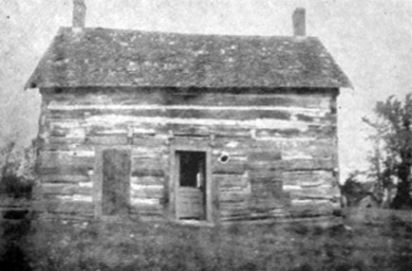
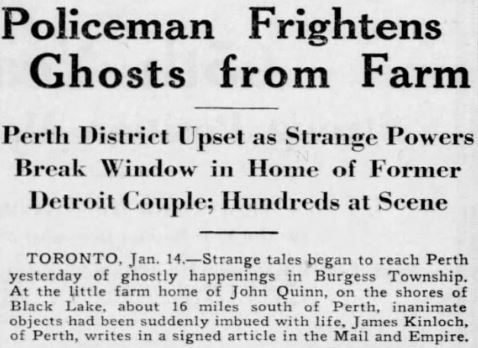

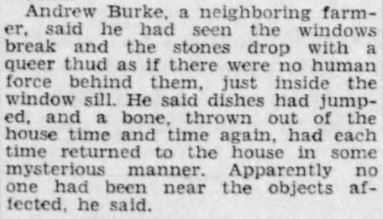


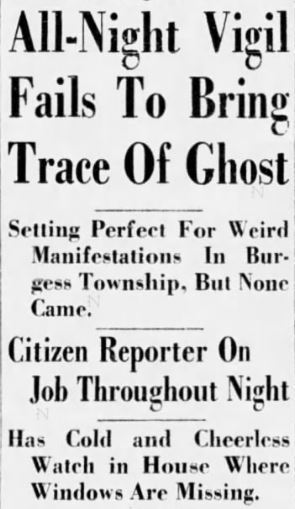
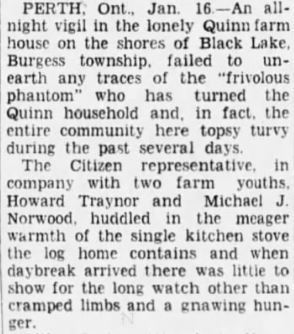
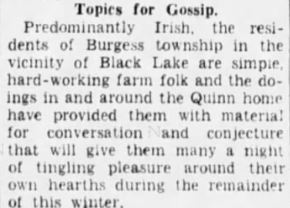
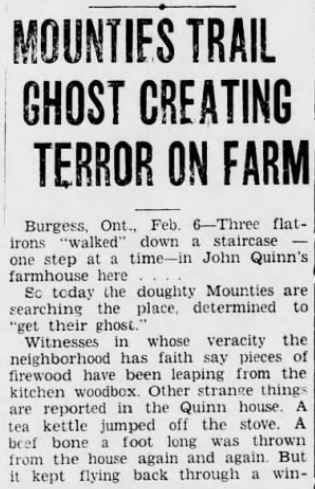
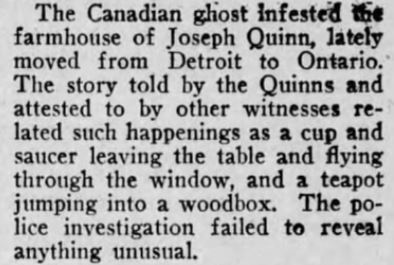
“Strange occurrences were happening in 1935 at a farm in North Burgess just off the Narrows Locks road. Mr. John Quinn, his wife and two children, Michael, and Stanley, ages 13 and 11, reported innumerable phenomena taking place in their home. Stove lids, according to the Quinns, “danced” in the air, the teapot “jumped” off the stove into the wood box, three flat irons “walked” down a staircase and dishes “pranced” on the dining-room table. Word of this mysterious goings on spread quickly throughout the district. Although, perhaps skeptical, hundreds of persons from miles around flocked to the Quinn home.
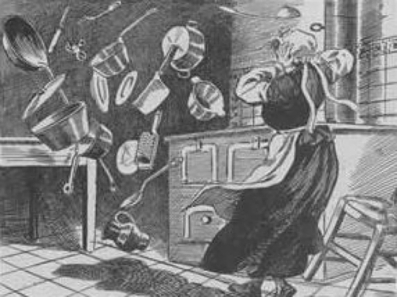
On the Sunday after the reporting of the “ghosts” more than 100 cars arrived at the Quinn farm. Along with the cars a flotilla of cutters and sleighs dotted the white-capped farm. The snow fell incessantly and the thermometer dipped way below the zero mark.
Newsmen from across the country arrived, and the CBC news from Toronto, reported the strange events. Although the strange occurrences could not be readily explained, many held doubts in their minds as the credulity of the phenomena. Believing that there had to be a reasonable explanation behind the occurrences, the Perth detachment of the OPP decided to hold an investigation.
On a Saturday afternoon, members of the force motored to the Quinn home, and inspected the building. Nothing strange occurred while they were there. That same evening Inspector Storey returned to the house. He remained there until Sunday morning along with about a dozen district men, sat in the house, speaking in hushed tones, but again nothing happened.
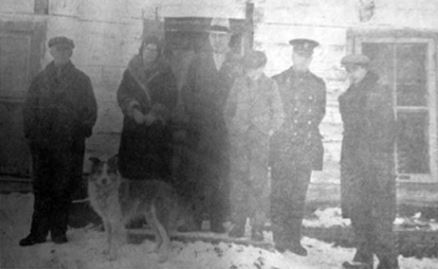
Mr. Quinn was unable to explain the strange occurrences that had been going on for the past couple of weeks. Pieces of beef he had placed in a barrel had been found littered throughout the house, he said, and the Wednesday before a window pane crashed for no apparent reason. He had not thought that too odd until it happened the very next evening.
Andrea Burke, a neighbouring farmer, declared that a bone thrown out of the home time and time again had always returned to the house for no explicable reason. Another neighbour, William Cordick, swore that he had seen three flat irons descend the Quinn’s staircase one after another.”
………………………………………………………………………………………………………………………………………..
Irish Settlers to North Burgess Township, Lanark CountyMost, but not all of the Irish in North Burgess Township, came from County Down and County Armagh, and many came in the 1840s, to escape a horrible famine, that swept through Ireland like an unstoppable plague. A disease called Potato Blight ravaged their crops for nearly a decade, and during that time over a million died of starvation, and an equal number fled Ireland on ships sailing to Canada and the United States.

Most were tenant farmers, leasing their land; unable to pay their rent when their crops failed, and were evicted by ruthless landlords. They bundled up what little they had, and boarded ships headed for the new world.
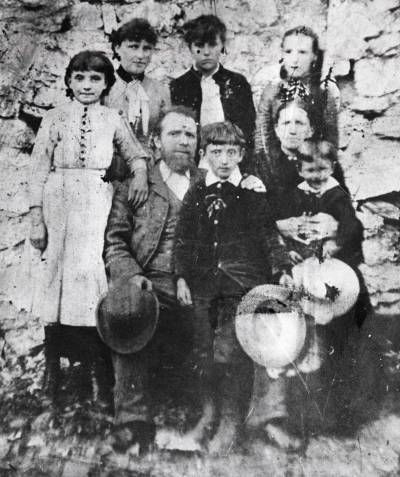
Seven weeks was the average length of time spent at sea, and the conditions endured by these Irish immigrants were so terrible that the ships were nick-named ‘coffin ships’. The lice, ticks and fleas common in these over-crowded vessels were the ideal breeding grounds for the transmission of disease, and by 1847 an average of 50 passengers died each day of typhus on their voyage from Ireland.
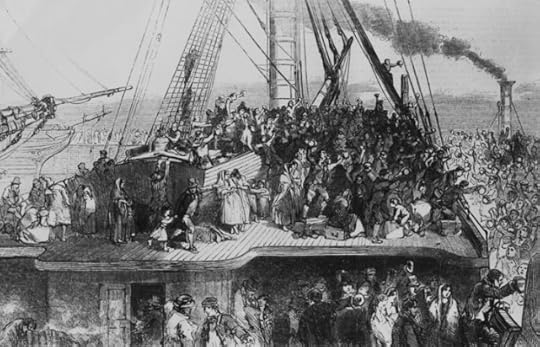
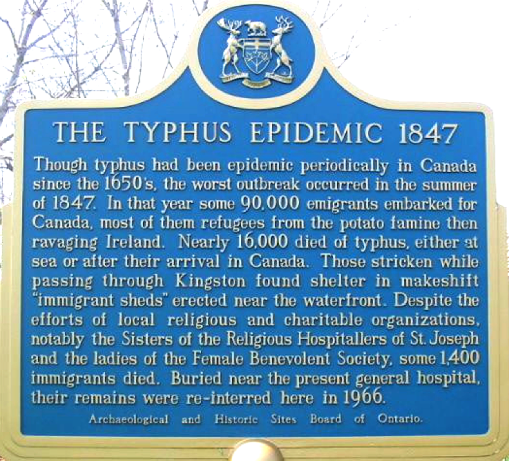

These new settlers brought their traditions, customs, and stories with them to the new country. Stories and legends were passed down from father to son, and from mother to daughter. Tales from the old country were told in the evenings by the fire, and the one story that seemed to run up and down the concessions in North Burgess was the legend of the Irish Banshee.

The Banshee, or ‘Bean Sidhe’ is an Irish spirit, and her high-pitched wail foretells of a death in the family. It was said that each family had its own Banshee, and that they travelled with them from the old country. Some said that the family’s Banshee would stay in Ireland at the family’s estate, and mourn the dead. The settlers to the new land brought their vivid descriptions of the Banshees – some claiming that she was an old hag with red eyes, but others said she was a fair, pale Irish beauty with long red hair dressed in a flowing gown.
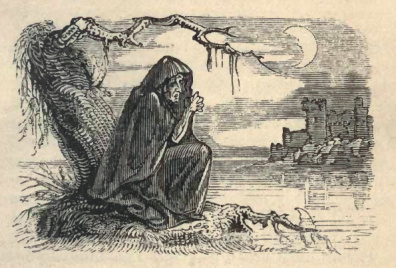

It’s been said that whoever hears her high and piercing shriek could be sure that there would be a death within 24 hours. Irish lore tells that the Banshee always wailed when a family member dies, even if the person had died far away, and news of their death had not yet come. The wailing of the banshee was the first warning to the household of the death.
When several banshees appeared at once, it was said to foretell of the death of someone prominent, or of an accidental or unintended death – often of a murder victim, a suicide, or a mother who died in childbirth.
The early settlers in North Burgess passed down their stories of banshees, fairies, ghosts and the little people. Although they were fiercely loyal to God and to the church, they never abandoned their beliefs in the spirits and creatures of their ancient folklore.
The Story of the Burgess Ghost became a local legend….The story of the ghost in the Quinn house was passed down through the years, told and retold at family gatherings, around campfires, and particularly in the weeks each year leading up to Hallowe’en.
In a strange final twist to the mystery of the Burgess Ghost, the Quinn family home burned to the ground. The cause of the fire was never determined, and remains a mystery to this day…..
In 1972, the Quinn home was burned to the ground.

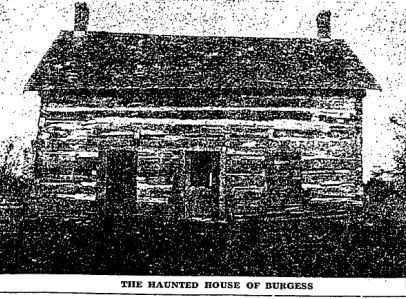
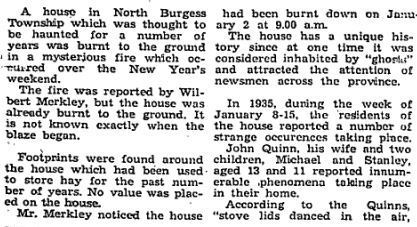
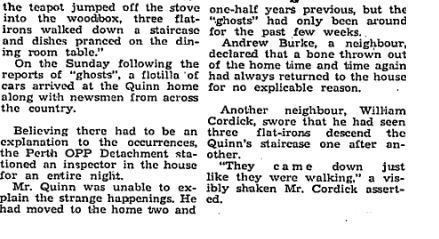
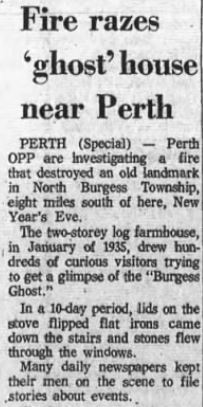
………
In 2002 the townships formerly known as North Burgess, South Sherbrooke and Bathurst were part of an amalgamation, and adopted the name of Tay Valley Township, as they are known today.
……..
For genealogical records of the founding families of North Burgess Township:
http://www.rootsweb.ancestry.com/~onlanark/nburgess.htm
St. Bridget’s Cemetery Staneyville Ontario
Roman Catholic interments North Burgess Township
Scotch Line Cemetery – Burials from 1822-2000 North Burgess Township
Scotch Line Cemetery – North Burgess
Lanark County Genealogical Society
Archives Lanark
http://archiveslanark.ca/index.php
Search the census records for North Burgess Township, Lanark County
Searchable online census records for Lanark County
……………
For more information on Irish Folklore in the early days of Lanark County:
‘Banshees of Burgess’, is part of a collection of short stories in ‘Lanark County Classics – A Treasury of Tales from Another Time’. The reader will discover more about the early families from Ireland who settled in Lanark County, and their customs and beliefs in the supernatural, brought from the old country. The story explores some of the tales passed down by these Irish settlers, and documents their personal experiences with Banshees, ghosts, and fairies while living in Lanark County.
“Lanark County Classics” – ISBN 978-0-9877026-54
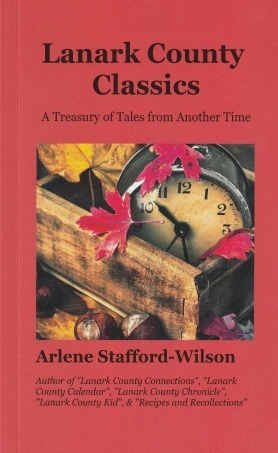
…..
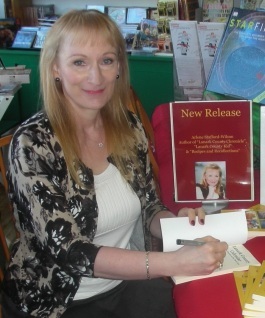
Arlene Stafford-Wilson
Honorary Life Member, Lanark County Genealogical Society
Lanark County Pioneer Families Humanitarian Award
Member, Association of Professional Genealogists
Author of : “Lanark County Kitchen”, “Lanark County Christmas”, “Lanark County Comfort”, “Lanark County Collection”, “Lanark County Calling”, “Lanark County Classics”, “Lanark County Connections”, “Lanark County Calendar”, “Lanark County Chronicle”, “Lanark County Kid”, & “Recipes & Recollections”
note: (map of Northern Ireland – By Maximilian Dörrbecker (Chumwa) – map by NNW, CC BY-SA 2.5, https://commons.wikimedia.org/w/index.php?curid=7918534)March 11, 2024
Irish Names & Surnames Explained
Traditional Irish Naming Patterns
Naming patterns are important when researching your family history. It has been a long standing custom in families around the world to name children after fathers, mothers, grandparents, important ancestors, relatives and friends. Middle names were often used for the preservation of a mother’s maiden name or the name of a prominent ancestor in that family. Names are very useful in tracking down lineages when there is little or no paper trail.
Names can give you clues to a person’s lineage, but other sources are still required in order to have genealogical proof. The Irish used a very particular naming pattern for children for children born beginning in the mid to late 1700s and through to the early to mid 1900s. It is important to note that not all Irish families followed the pattern although enough of them did that you can often use first names to learn more about an Irish ancestor’s unknown lineage. As with anything in genealogy, this should be proven with supporting documention, but Irish naming patterns are often helpful while building your family tree.
Traditional Irish Naming Pattern:
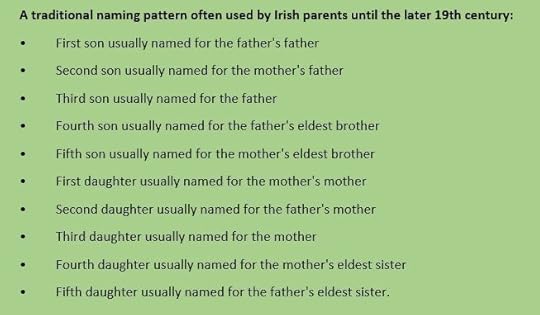
Naming Pattern Exceptions:
Naming patterns were sometimes affected by deaths in infancy. When a specific name was considered important within the family, the name would usually be given once again, to the next-born infant. In records, there are sometimes two or more children of the same name, baptized within the same family. Each baptism of this name, usually tells of the death of the older child of the same name.
Another example when the naming pattern is altered is when a child was stillborn, or very ill when born, or dying. Sadly, the child was baptized using a less-important family name, but the name of the paternal grandfather (or important ancestor) might be ‘reserved’ for a live birth, or for a child who was expected to live.
Surname Prefixes
Irish surnames of Gaelic origin were more common until Ireland fell under English rule. This led to the use of English versions of traditional Irish surnames. Many of these traditional names had prefixes:
“O”, “Fitz”, “Mc” and “Mac”
Mac or Mc – meaning “son of”
O – meaning “grandson of”
Fitz – meaning “son of” was sometimes substituted for the prefix ‘Mac’ or ‘Mc’ by many of the descendants of Anglo-Norman invaders.
For a period of time, English law in Ireland forbade the use of “O”, “Mc” and “Mac”, although “Fitz” was allowed. When researching your family name be aware that a name like Connor could have once been O’Connor.
The prefix O’ is unique to Ireland. It originates from the Gaelic word “ua,” meaning “grandson of.” Any name beginning with O’ is without question an Irish patronymic (from a male ancestor). The O’ surnames began in the 11th century in Ireland, before the Mc/Mac surnames. Examples of these surnames are O’Sullivan, O’Connor, O’Brien, and O’Leary.
Mc or Mac?
There is a myth about Scottish and Irish surnames that begin with the prefix Mac- or Mc-, that Mac- (as in MacDonald – son of Donald) designates a Scottish and Protestant heritage, where as Mc- (as in McCormick – son of Cormac) denotes an Irish Catholic family name. In fact there is no difference between these two prefixes. They may be either Irish or Scottish in origin and spelled different ways, with either prefix, even within the same family.
Mac- and Mc- both come from the Gaelic word “meic,” meaning “son of.”
“Micks”
In the early days of Irish settlement in Canada, such a large number of Irish names carried these prefixes that it became an ethnic slur for the Irish people to be called: “micks.”
Surnames that Describe the Profession of the Father
Some names beginning with Mc or Mac described the profession of the father.
MacMaster -“son of a master or religious leader”
Macpherson – “son of the parson,”
MacWard – “son of a poet or scribe,”
MacKenzie – “son of the fair one,”
MacDuff – “son of the dark one,”
McDowell – “son of the dark stranger.”.
Some families chose to conform to English laws, and some didn’t, which led to surname variations within the same family. Often Irish who emigrated dropped the prefixes when they arrived at their new countries of residence.
Top 200 Surnames in Ireland
Given Names and Meanings –
– BOYS
Given Names and Meanings
– GIRLS

Researching Your Irish Roots
Don’t forget Nicknames
Most given names in Ireland have at least one associated nickname. When names are recorded in birth, marriage, and death, or in church records, a nickname may have been used instead of the given name (Kate for Catherine or Billy for William, for example). Many nicknames are easy to spot, but others are less well known. For example, the nicknames used for Bridget include Bedelia, Bess, Bessie, Biddy, Breda, Briddy, Bride, or Bridie.
Nicknames may also lead the researcher astray if incorrect assumptions are used. While some might assume that Anty is a nickname for Anthony (a male), it is, in fact, more likely a nickname for Anastasia (a female). Lou is both a nickname for male children named Aloysius, Lewis/Louis, and Ulysses as well as female children names Louise or Lucinda or Mary-Louise, or Mary-Lou.
In conclusion, while naming patterns weren’t always followed exactly (for example if there were only one or two children, the father’s relatives always took precedence in the naming of the children), they were usually followed closely.
Remember, if you have an Irish ancestor, and don’t know anything of their parentage, you can use naming patterns to help in your search.
Best of luck researching your Irish ancestry!

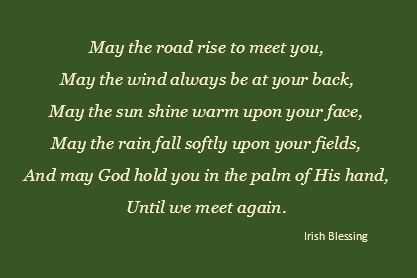
Sources:
De Breffny, Brian. Guide on Irish Christian Names and their English equivalents. Article Christian Names in Ireland found for years 1670-1850. The Irish Ancestor, Vol.1 No. 1, pages 34-40.Coghlan, Ronan. Irish First Names. Belfast, Ireland: Appletree Press, 1985.Ó Corráin, Donnchadh, and Fidelma Maguire. Irish Names. 2nd ed. 1990. Reprint. Dublin, Ireland: The Lilliput Press, 1992.MacLysaght, Edward. The Surnames of Ireland. 6th ed. Dublin, Ireland: Irish Academic Press, 1985.Matheson, Sir Robert E. Special Report on Surnames in Ireland [Together with] Varieties and Synonyms of Surnames and Christian Names in Ireland. 1901. Reprint. Baltimore, Maryland: Genealogical Publishing Co., 1968.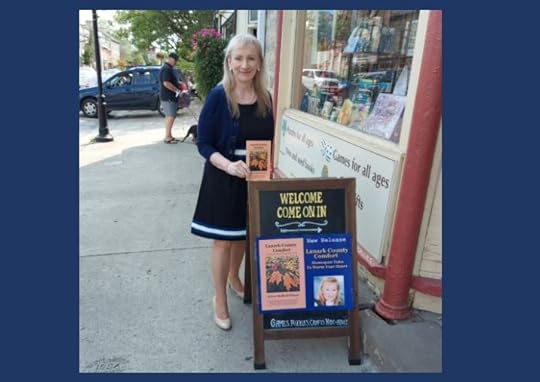
Arlene Stafford-Wilson
Honorary Life Member, Lanark County Genealogical Society
Member, Association of Professional Genealogists
Lanark County Pioneer Families Humanitarian Award
Author of : “Lanark County Christmas”, “Lanark County Comfort”, “Lanark County Collection”, “Lanark County Calling”, “Lanark County Classics”, “Lanark County Connections”, “Lanark County Calendar”, “Lanark County Chronicle”, “Lanark County Kid”, & “Recipes & Recollections”
and “Lanark County Kitchen: A Maple Legacy from Tree to Table”
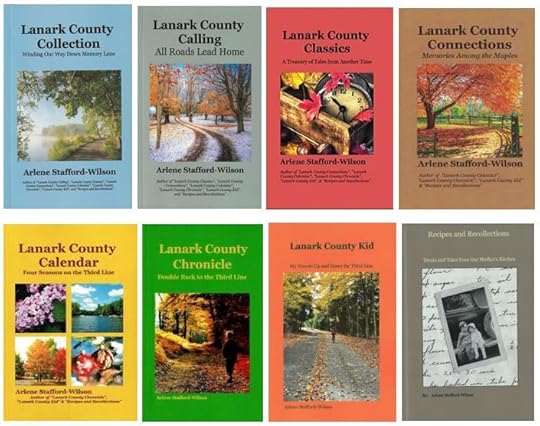
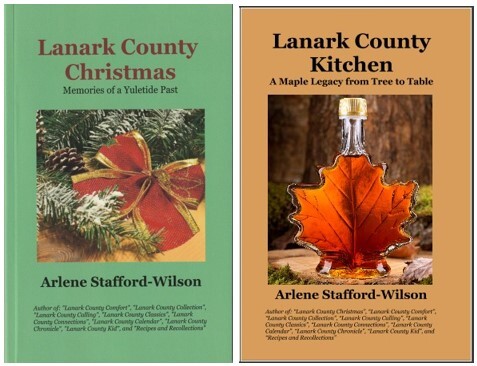
February 20, 2024
100th Birthday at Dalhousie Lake
Mary Ferguson McIntyre
“Life, we’ve been long together!”
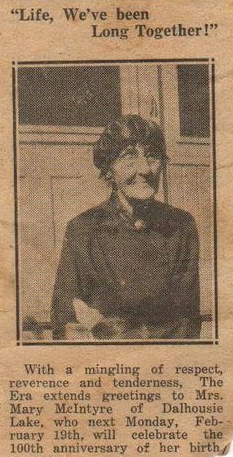
Mrs. Mary F. McIntyre Celebrates Her 100th Birthday at Dalhousie Lake
(transcribed from Feb. 23, 1934, edition of “The Perth Courier”)
Showered with congratulations by neighbours, friends, and acquaintances, still healthy in body and mind.
“Lanark County’s grand old lady, Mrs. Mary Ferguson McIntyre, celebrated her 100th birthday on Monday, February 19th, at the home of her son-in-law and daughter, Mr. and Mrs. Walter Geddes, Dalhousie Lake, when she was showered with congratulations by many of her neighbours, friends and acquaintances. Mrs. McIntyre was also honoured when the news of her 100th birthday was broadcast by radio from a Toronto station.
Mrs. McIntyre was born in North Sherbrooke Township, Lanark County, on February 19th, 1834. With the original settlers about 1820 came the representatives of two Scotch Highland clans, Mr. Duncan Ferguson of Argylshire and Mr. Alexander McDougall of Perthshire. Soon after their arrival in the new land a son of Mr. Ferguson married Miss Violet McDougall and to them a daughter, the subject of this sketch, was born. The parents could speak little or no English, only their native Gaelic, and the little daughter taught this in the parental home, could speak it fluently and in fact never wholly forgot it up to the present time. Of course, association with lowland neighbours and teaching at schools brought a knowledge of the Anglo-Saxon tongue and this became her thinking language. The first schoolhouse in North Sherbrooke was built at Elphin in 1834 and there Mrs. McIntyre received her early education.
Her husband, the late Peter McIntyre died about 25 years ago.
During her long-life Mrs. McIntyre has seen the greatest growth in farm cultivation and improvements through many a year of hardship and privation of the early settlers until the original cabins have been changed into comfortable homes, and the very primitive log school houses succeeded by modern ones of frame and brick all over her native township. The course of progress along life’s highway has been the history of her own life – the sickle, scythe, cradle and kindred working implements have all passed during her life on the farm to be succeeded by the more modern implements of the present time. In her girlhood days there were no bridges across the broad Mississippi River, and the way to the market in Lanark Village and Perth involved much hardship. She often walked to Perth or rode on ox carts, horseback, rough sleighs, cutters and wagons.
At present, she is in almost perfect health, a slight difficulty of hearing being her only complaint. It is a pleasure to know that in her daughter’s and son-in-law’s home she has found congeniality and affection in the evening of her long life.
The Reception
Relatives and friends from far and near in large numbers were present at the reception tendered in Mrs. McIntyre’s honour, those from a distance including Mrs. Sam Campbell, of Brighton, and Mrs. James Geddes of Powasson.
The house was beautifully decorated with pink and white streamers, and in the center of the table was set the birthday cake with decorations in the form of an arch on which was seen a miniature moon, stars, and snow, and underneath the arch written in gold: “100 Years.”
Messages and congratulations poured in from friends at a distance, two in particular being of a novel and pleasing nature, from Mr. Thomas Nesbit of Chicago, a gramophone record of his own voice with greetings and good wishes to Mrs. McIntyre and the following verses composed by Mr. Wm. B. Nesbit of Swanson, Saskatchewan:
To Mrs. Mary McIntyre on her 100th Birthday:
Oh come my muse my pen inspire,
A rhyme to Mary McIntyre,
Her natal day is drawing near,
She soon will reach her hundredth year;
And looking back down through the age,
What wonderous stories mark the page,
For five score years to live and move
Tasting sorrow, joy and love;
What memories must fill her mind
Of those whom she has left behind,
Who must have fallen by the way
Like flowers that blossom for a day;
Or like the leaves that fade and fall
Are buried by the winter’s pall,
Methinks I see far down the years,
Old Sherbrooke to my mind appears;
Unbroken wilderness around
No fertile fields that sow are found,
Bur pine and maple, elm and beech
Dense forests far as eye can reach;
And through the valley in between
Dark swamps of fragrant evergreen,
Now came the sturdy pioneer
From heather moors in Scotia dear;
McDougall clan, the Fergusons
The McIntyre’s all worthy sons,
And many more of Scottish birth
No better people graced the earth;
With axe in hand and labour vast
A clearance in the bush at last;
A wee log biggin’ hearth stone fire
And mayhap stone, a barn, a byre;
And as I listen I can hear
A lassie singing sweet and clear,
An axe blow in a nearby bush
As down the creek the waters rush;
An oxcart creaking o’er the hill
From Perth or Lanark or the mill,
Or off to Bytown with potash
To sell and get a little cash;
To buy the tea or pay the tax
Or other needful new knickknacks,
Those were the days of frugal life
And thrifty ways for man or wife;
They were compelled to live that way
For things were scarce and far away,
And many a long and weary road,
Was travelled with a heavy load;
I often think that folks today
Do not appreciate the way
Their forebears used to toil and save
With hardships great and patience brave;
We often hear complaints today
But had we lived the self-same way,
Our present troubles would be less
Things wouldn’t be in such a mess;
The Lord’s been good, ‘tis man that made
Conditions bad I am afraid,
Our aged friend through life has seen
Development of the machine,
From sickle frail unto the hour
Of steam and gas and hydro power
Now cars go rushing here and there,
And airplanes fly through the air,
The telegraph and telephone
When she was young were quite unknown;
Now radio from everywhere
Brings news and music to the ear,
But I’m not sure in every way
That folks are happier today.
Now my best wish to her shall be
That she may have sweet memory
And happiness and peace serene
With naught of sorrow in between;
I often think I’d like to go
And see the faces that I know,
And if I’m spared perhaps I will
And come around by Watters’ mill;
These rambling lines I dedicate
To all who meet to celebrate
This wondrous anniversary
Best wishes to you all from me.
Written by: Wm. B. Nisbet, Swanson, Saskatchewan
published: Feb. 23, 1934, “The Perth Courier”

Obituary, “Lanark Era”, January 30, 1935
“Dalhousie Lake, 25th Jan., Mrs. Peter McIntyre, in her 101st year. Born in North Sherbrooke 19th February, 1834, the daughter of the late Duncan Ferguson and his wife, Violet McDougall. On Feb. 17th 1852 Mary Ferguson was married at Perth to Peter McIntyre by the late Rev. Wm. Bell. Her husband died March 31st, 1897. Survived by one daughter, Mrs. Walter Geddes, of Dalhousie Lake (Violet); and one adopted daughter, Mrs. Roy Kilborn, of Renfrew (Alice). Burial in Crawford’s Cemetery.”
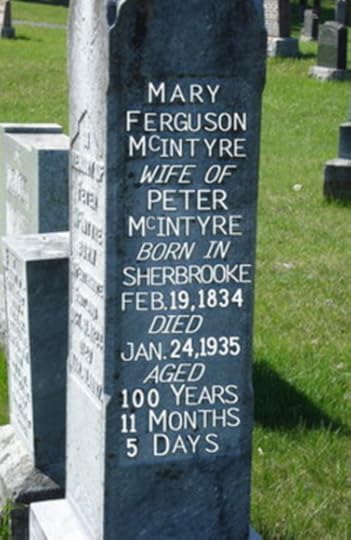
Mary’s Memories:
An Excerpt from Elphin, McDonalds Corners and Snow Road Churches Centenary Book (1875-1975)
PIONEER DAYS OF NORTH SHERBROOKE
As remembered by Mrs. Peter McIntyre (nee Mary Ferguson), better known as Auntie Mary, who died January 14, 1935, aged almost 101 years
The township of North Sherbrooke was surveyed in 1820-21 and received its name from an officer of prominence in the French Colonial Forces whose name was Sir John C. Sherbrooke.
The first settlers belonged to a society formed in Scotland, named “Lesmahago Society”, and those were John Porter, Daniel Ritchie, Jas. Gilmour, Anthony McBride, Ebenezer Wilson, Duncan McDougall, Archibald McDougall, Arthur Stokes, Wm. Christelaw, Josiah Davis, James Nesbit, and Alex. Young.
Elphin is a little village situated in this township, which was once called Mann’s Corners, after a man by that name. As far as can be learned, Elphin got its name from an English General named Elphinstone.
The first school was a log building across the road from the present one, except down on the corner. It was burned, and another was erected on the same ground our present school being the third built. The first church was built where the Crawford Cemetery now is. Then they built at Elphin the building known as the old Sunday School recently sold and torn away by Charles Stewart. The present church was built in-1894. A few of the settlers were Baptists, and held service in a little church on the second line where a few graves still remain on the farm now owned by Haddon Wilson (now Delmer Paul).
The first store was situated on the property now owned by Mrs. J.H. Miller (now Fournier’s), opposite the spot where Charles Stewart’s (now Fair’s) house now stands. This was run by Germans, Mendels and Silverstone. Then Mr. Mann kept store on the old McFarlane property now owned by Alex. Duncan (Wilmer Gemmill). Then a store was built and run by Peter McIntyre on the property now owned by C.M. Stewart. It was next run by Tom Crawford until the time it was burned. Then the store where it now stands was built by Tom Crawford, and afterwards it was run by Charles McConnell, Isaac Allan, Mac McIntyre and now Peter McLaren. (Ted Oxtobee was the next owner-now it is an antique shop)
There was an old building across from where the hall now stands which was used as a blacksmith shop; but in later years Malcolm McIntyre built a shop on the property now owned by Alex. Duncan (Wilmer Gemmill) which was burned about the year 1920.
The first male child born in North Sherbrooke was Bob Love, uncle of Thomas Love, and the first female child was Agnes McDougall, now Mrs. Hall of Perth.
In the house where Mrs. J.H. Miller (Fournier’s) now lives, a shoe-maker carried on a business. One who in later years worked at this trade was Billy McIntosh
The farm now owned by Sam Larmon was first owned by Wm. Bryce, whose wife’s name was Christelaw, of English descent. Next came Duncan Campbell, Duncan McIntyre, Alex McIntyre, and now Sam Larmon.
The first owner of the farm in the valley was Wm. Bryce Sr. who emigrated from Scotland. His family was as follows-Wm. Bryce, Jr., Jack Hugh (who married Margaret McDonald, daughter of John McDonald and Peggy Harrower), Lizzie (married Thomas Trimble), Jean (married Thos. Donaldson at Oliver’s Ferry), David (whose first wife was Violet Howie of Iowa–issue two sons John and James; his second wife was Marion Love). David Bryce succeeded his father in ownership and later sold it to Peter McIntyre whose wife was Mary Ferguson, daughter of Duncan Ferguson and Violet McDougall. They had one daughter, Violet Anne, now Mrs. Walter Geddes, Dalhousie Lake. Next owner was J.W. Munro (Boyd’s Settlement) who married Mary Rutherford, daughter of Wm. Rutherford and Anne Ferguson. He sold it to Malcolm McIntyre, son of Duncan McIntyre, and who married, Tena Purdon, daughter of Wm. Purdon and Lizzie McDougall. He is the present owner. (Arnold Long’s)
The next farm now owned by George Weir, having no tenant, was first owned by Geo. Harrower, then Donald McDougall and his wife Minnie Thompson, then by Eby. Geddes, and then Jas. Campbell.
The next farm owned and occupied by George Weir, was, first owned by Jas. McDonald, son of John McDonald and Peggy Harrower, then Walter Sim whose wife was Hannah Harrower of Perthshire, Scotland, then Laghlin McIntyre, then Hugh Weir and his wife Elizabeth Hodgson of Peterhead, Scotland and now George Weir and his wife, Margaret Delyea. (This farm is now occupied by Geo. Weir’s daughter, Mrs. Marjorie Closs)
The first owner of the next farm was Jas. Tweedle (Twaddle), then Duncan McDougall who married Jean Bain, daughter of John Bain of the stone house. Next James Mann, then Robert Balfour, his son James Balfour, and now Alex McIntyre who married Annie Gilmour–issue one daughter Eva, and one son James. (Ray Purdon now lives on this farm).
The farm now owned by Wm. Balfour was first owned by Robt. Smith, the next owner was Duncan McIntyre Sr., Duncan McIntyre Jr., then Pitchers and now Wm. Balfour, (Mary Brownlee) (now owned by Ken Brownlee).
The farm which now is Jas. McVean’s was first owned by David Wylie (Bella McVean’s), and the spring beside the road on this farm was always known as Wylie’s spring
The farm now owned by R.L. Brownlee was owned by a man by the name of Stockes (Stoakes and later Stokes)before the Brownlees of earlier days. R.L. Brownlee married Edith McDonald, issue-four sons, Mervil, Gordon, MacDonald and Kenneth. (now Ken’s).
The old McConochie Homestead now owned by Peter McIntyre (Robt. Ferguson’s) was first owned by Hugh McConochie and his wife Katie Ferguson of Argyleshire, Scotland, issue–Sandy (married Betty Sim, daughter of Walter Sim and Hannah Harrower), Margaret (married John Miller, son of Matthew Miller, soldier), Jean (married a Mr. Muir), Janet (married Jas. Colquhoun of Hibbert), Duncan (married Jeannie Ferguson), Katie (married George Wilson and lived on the homestead until sold, when they moved to Smiths Falls), Mary (married Robt. Wilson), Bella (married Tom Colquhoun of Hibbert). The farm is now owned by Peter McIntyre who marred Catherine Corley, issue-one daughter Mary.
The next farm was first owned by Duncan Ferguson, nephew of Hugh McConochie, Strachur Ban, Argyleshire, Scotland. He and his sister Mary sailed with the McConochie family. Mary died in Perth where she was a maid at Rev. Mr. Bell’s. Duncan married Violet McDougall, daughter of Alexander McDougall and Janet Clark. His family consisted of, Mary (married Peter McIntyre, son of Duncan McIntyre and Ann Ferguson), Katie (married Ebenezer Geddes), Peter (married Mary Rutherford), Janet (married Robt. Lee), Alex (married first Katie Buchan, then Agnes Geddes), Maggie (married Robt. Nisbet), Duncan (married Deborah Love). David Nisbet now owns the farm but it is untenanted. (Murray Nisbet’s farm),
The farm now owned by Sam Cameron was first owned by Robert Sim, brother of Walter Sim, father of Jane Sim, who became the wife of Hon. Alexander McKenzie, Prime Minister of Canada. Then John McDougall and his wife, Mary McNicol, then Todd’s who moved to Minnesota, next Peter Ferguson who gave it to Duncan Stewart. It is now owned by Sam Cameron and his wife Annie Adam, issue one son, Garnet.
The farm now owned by Sam Gordon was first owned by Duncan Ferguson and his wife, Barbara Currie, sister of John Currie who erected and operated the first grist mill at the head of Dalhousie Lake and now operated by Walter Geddes, son of Adam Geddes and Jane Sim, Duncan Ferguson’s family were: Hugh who died a young man on board a boat coming East from the Great Lakes and was buried in Kingston; Barbara, Nancy, Dan, Jeannie and Duncan (twins), John, Katie, Sandy, Mary. Barbara married Robt. Bain, son of John Bain who built the stone house later owned by John Ferguson and Catherine Stewart. Nancy married Dan Geddes, son of David Geddes and Agnes Lambie, Dan married Katie Currie his cousin [probably error here: Donald, not Dan, married Katie Currie, daughter of his uncle John Currie], Jeannie married Duncan McConochie, son of Hugh-McConochie and Katie Ferguson, Duncan married Elizabeth Robertson, John married Bella Budd, Katie married Mr. Erskine, Sandy married Janet Gilmour, Mary married Jas. Gordon in Minnesota. The farm is now owned by Sam Gordon and his wife Nellie Campbell (deceased), issue–George (married Hilda Beatty), Sherman, Gerald and Florence.
McIntyres:
Duncan McIntyre Sr. (my husband’s father) had twin brothers. John settled near Perth, Robt. a merchant in Renfrew also a member of Parliament, later owned a wholesale business in Montreal, had one son Peter who returned to Fortobella, Scotland. Two sisters, Katie and Janet, married in Scotland and never came to Canada. Among their best friends were the Ferguson family. Duncan McIntyre Sr. married Ann Ferguson and came to Canada with their family: (Margaret married John Anderson of Beckwith) issue–one son Peter who emigrated to Ohio. (Elizabeth died young), Mary married John Gunn of Hopetown, issue–John died young. Duncan married Margaret Gunn (no relation), Finley married a girl from Western Canada, George died young, Mary married Wm. McKinnon, Peter married Mary Ferguson, issue–one daughter Violet who marred Walter Geddes, issue–Robt., Ada (deceased) and David. Malcolm went to the United States and joined the army, he married over there but had no family, John married and lived in Lanark, Duncan Jr. married Jeannie Glenn, issue-Duncan married Tena Watson, Malcolm married Tena Purdon, Peter married Catherine Corley, Alex. married Annie Gilmour, Katie married Thos. Duncan, Maggie married John Trombley, Annie married Peter Anderson, Charles never married and died at the age of 63, John died at the age of 2 years, two infant girls died, the youngest of the family.
As remembered by Mrs. Peter McIntyre (nee–Mary Ferguson)
Historical sketch of McDonalds Corners, Snow Road and Elphin, by Hilda Geddes; Kenneth McCaskill.
From: The Centenary of the Presbyterian Church in Canada, 1875-1975.
Mary lived a long life and saw many changes throughout her days on earth. From the earliest times of the Scottish pioneer settlement, through to the advancements of the mid-1930s. Mary would see transportation change from the ox to the horse and wagon, to the automobile. She saw the lands around her change from dense forests, to farmlands cleared and thriving with crops. Mary’s story and the celebration of her milestone birthday gives us a glimpse into days gone by, of a simpler time, a life well-lived, and roots reaching back to some of our earliest Scottish settlers in Lanark County.
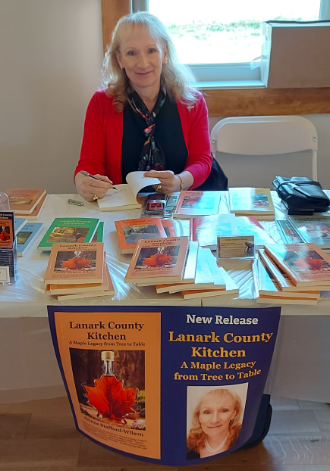
Arlene Stafford-Wilson
Honorary Life Member, Lanark County Genealogical Society
Member, Association of Professional Genealogists
Lanark County Pioneer Families Humanitarian Award 2023
Author of : “Lanark County Kitchen”, “Lanark County Christmas”, “Lanark County Comfort”, “Lanark County Collection”, “Lanark County Calling”, “Lanark County Classics”, “Lanark County Connections”, “Lanark County Calendar”, “Lanark County Chronicle”, “Lanark County Kid”, & “Recipes & Recollections”
February 15, 2024
Lent: 40 Days without Ice Cream
I can’t blame the local clergy in Bathurst Township, for believing it was the church telling people it was wrong to eat ice cream before Easter. By the time I was in grade 7 or 8, at Glen Tay Public School, I figured out for myself that it was Mother’s choice to ban ice cream from our old chest freezer, during the 40 days of Lent.

Lent began with Ash Wednesday each year, and was a time for moderation, reflection and spiritual discipline, in the weeks leading up to Easter. It doesn’t have anything to do with ice cream; at least not at anyone else’s house……….but it did at ours.
Mother loved ice cream; particularly vanilla ice cream. Although she was just an average-sized person, she had no trouble at all polishing off an entire gallon by herself, after the supper dishes were done. She’d grab a tablespoon, and the carton of vanilla, and head for the couch in the living room. When I think back now, it wasn’t even particularly good ice cream; at least not compared to what we can get today. She would buy the cheapest ice cream she could find, which was usually the ‘Top Value’ brand from the IGA store, on Wilson Street in Perth.
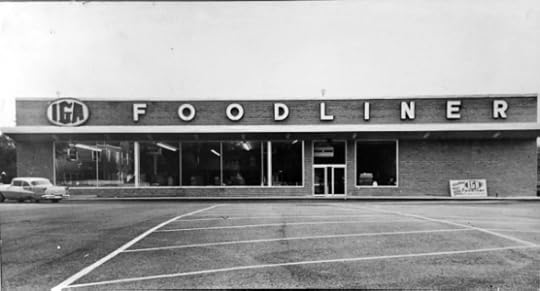
Once she’d opened the carton and dug that tablespoon in, we all knew that the ice cream’s days were numbered. She wouldn’t always finish the whole thing at one sitting, but she’d have a good go at it for sure. Sometimes she’d complain later that evening that her stomach was troubling her, or that she had indigestion. She’d look over at Dad sitting contentedly in his lazy-boy chair, and ask him if she could have one of his Tums that he always carried in his pocket. She’d go on to say that she didn’t know why her stomach felt at bit ‘off’, despite the fact that the carton would be empty, and laying defeated in the garbage can, in the back porch. Dad was always too polite to say what was obvious to the rest of us.
A Family TraditionMother often told us about growing up in the 1920s in Edmonton, and how each night her mother sent her to the corner store, to buy a vanilla ice cream cone. She carried it home gingerly, catching drips on her tongue, before handing the prize over to her mother. Maybe this is where her love of ice cream began, although that still does not explain how she managed to consume it in such huge quantities.

So, as Lent rolled around each year, very early in the spring, Mother would announce that she would be giving up ice cream for the next 40 days. For the six weeks that followed, true to her word, there would be no cartons of ice cream in our shopping cart at the Perth IGA, no sign of the stuff in our old chest freezer. There were no cones consumed, nor ice cream sundaes, not one banana split, or even a vanilla shake; not a drop of the stuff in the house, for a month and a half.
Looking back, I understand now that the absence of frozen dairy products in our house wasn’t a rule imposed by the clergy. It wasn’t religious doctrine from our Calvin Church in DeWitt’s Corners. No, it was nothing of the sort.
Calvin United Church, Cameron Side Road, Tay Valley Township, Lanark CountyMother’s ChoiceIt was Mother’s own choice, to give up her favourite food, for the forty days of Lent each year. It was her way of giving up something that she loved; her small sacrifice. It was her way of showing a little spiritual discipline, leading up to one of our most special holidays of the year.
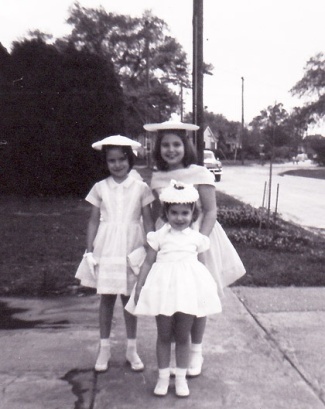
To me, Lent was one of the signs that spring was on its way, after the long, harsh, winter in Lanark County. Soon the snow would turn to rain, and wash away all of the signs of the dark, dreary, months behind us. The days would stretch out a bit longer, as the mercury rose a little higher in the old thermometer, outside our kitchen window. Soon Easter would be here, and we’d be dressed in our finest hats, and little white gloves, at Calvin Church, and yes, Mother would be eating her beloved ice cream once again.
…………………………………………………..
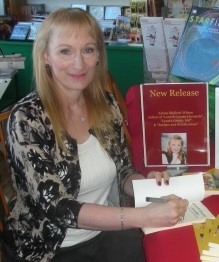
Arlene Stafford-Wilson
Member, Association of Professional GenealogistsHonorary Life Member, Lanark County Genealogical SocietyLanark County Pioneer Families Humanitarian AwardAuthor of : “Lanark County Christmas”, “Lanark County Comfort”, “Lanark County Collection”, “Lanark County Calling”, “Lanark County Classics”, “Lanark County Connections”, “Lanark County Calendar”, “Lanark County Chronicle”, “Lanark County Kid”, & “Recipes & Recollections”and “Lanark County Kitchen: A Maple Legacy from Tree to Table”( “40 Days Without Ice Cream” is an excerpt from “Lanark County Calendar: Four Seasons on the Third Line”)
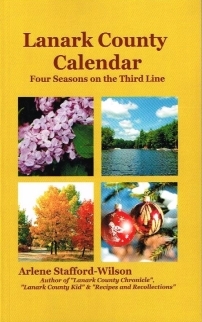
February 10, 2024
Murphy Tragedy
There are only few visible reminders now, more than 150 years after the pioneer Murphy family suffered one of the saddest tragedies imaginable. Small traces, here and there, in the former North Burgess Township of Lanark County, like the sections of land where they farmed after arriving from County Armagh, Ireland.

A section of the former Murphy family land in North Burgess Township, Lanark County
Like many of the settlers, Francis ‘Frank’ Murphy (1797-1848), and his wife Margaret (Hughes) Murphy, (1800-1875), left the old country, hoping for a better life for themselves and their children. They set sail for the new world, as many did, at the height of the potato famine in Ireland. During those incredibly difficult years, so many from the emerald isle settled in the township of North Burgess, Lanark County that some called it, “the Irish invasion”.
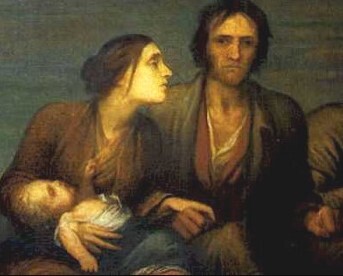
a painting depicting an Irish family onboard a ship headed for the New World
A Death at Sea
At least a million people died in Ireland during what became known as the “Great Famine” between 1841 and 1851. Two million people emigrated abroad during and after the famine. Thousands more perished on the long journey, or soon after their arrival in North America. Frank Murphy was one of those who died at sea on his way to Canada, in 1848, leaving Margaret and their children without a husband and father in a strange new land. Frank’s death would not be the last of the Murphy family misfortunes, and some say it was a bad omen of things to come.
At the time of the 1851 Census of North Burgess Township, Margaret, age 50, and five of her children were living on the farm: Mary, age 23, Terence, age 19, John, age 18, Susan, age 17 and Betsy, age 12. By 1861, only Margaret, Terence, and Betsy remained on the farm.
Frozen to Death

On February 6, 1874, Elizabeth ‘Betsy’ Murphy’s frozen body was found along the road in North Burgess Township, outside of Perth. Betsy, age 34, had traveled to Perth the previous evening with her brother, Terence, age 42, in their horse and buggy. When questioned about her death, Terence stated that his team of horses got away and he ran after them. He also claimed to be in an advanced state of intoxication and had little memory of what had happened on that fateful Friday evening on the way back from Perth.
Below, a transcription of an article (also below) which appeared in “The Perth Courier”, on February 13, 1874.
“An occurrence of a melancholy and somewhat shocking character took place in this vicinity within the past week, which calls for a close and scrutinizing examination by our authorities and court officials. We will briefly narrate the leading circumstances:
On Saturday morning last, the body of a young woman named Elizabeth Murphy was found dead by the roadside in the Township of North Burgess, about twelve miles from Perth, the unfortunate creature having been apparently frozen to death. The story of the sad affair is something like this.
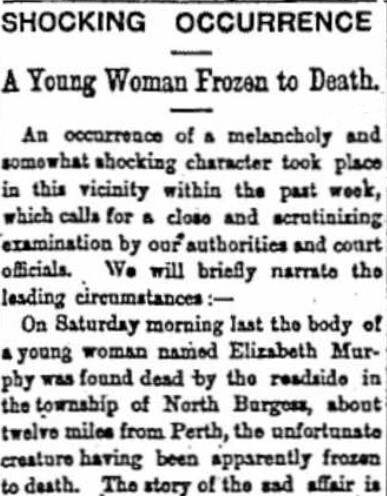
It seems that she and her brother, Terence Murphy, came to Perth on Friday forenoon and started for their home again in Burgess in the evening – it is believed, somewhat intoxicated. The next morning, the body of the girl was found on the road, lifeless, with marks of violence about the face and head. Her brother professes total ignorance as to what occurred before and after this had transpired, pleading an excess of intoxication which deprived him of the power of observing what took place around him, or in fact to himself – save in one thing: he has, he says, an indistinct recollection of the horses running away. To those who are charitable enough to take cognizance of this fact, only, and leave out other circumstances bearing on…
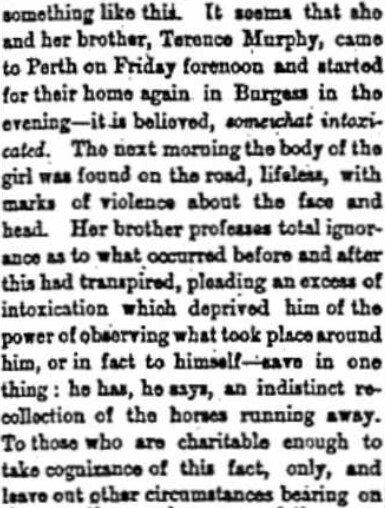
the case, the running away of the team may sufficiently account for the bruises that appeared upon the body of the girl. But it appears that the brother was not so drunk as he endeavored to make it appear. Parties giving evidence at the inquest swore that they saw him looking for his horses after they had run away, very far from being so far gone in intoxication as his testimony made it appear; and his own mother testified that when he got home, before commencing the search after the runaway animals, he was sober enough to make his own tea. Though this does not establish anything, of itself, still it convicts him of falsifying his evidence; and goes to prove at least an amount of cold-blooded indifference as to his sister’s fate, after she was thrown out of the sleigh which confounds our ideas of humanity and fraternal affliction. It is probably that the charge of inhumanity in not looking after his sister…
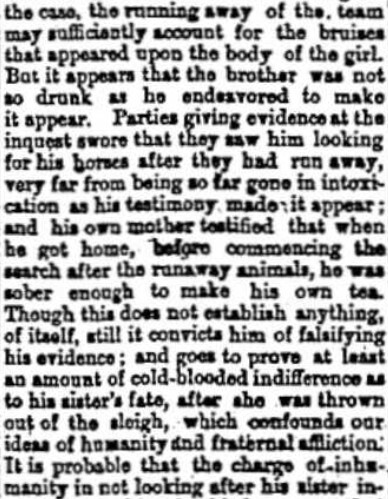
…instead of searching for his horses, on that freezing night, when by the best of evidence he knew she must be injured, is all that will be brought home to Murphy. Still it is an affair that demands investigation.
On Sunday last, upon proper representation of the affair having been made, Dr. Howden of Perth, Coroner, set out for the place and proceeded to hold an inquest on the remains. After hearing the evidence of several parties knowing more or less of the circumstances we have given above, including that of Terence Murphy himself, the Jury, through their foreman, Mr. Patrick Dooher, returned the following verdict: ”The Jury upon oath find that the deceased came to her death on the night of 6th February, through injury and exposure – the result of being left on the road while driving in company with her brother, Terence Murphy on the aforesaid night, and the Jury are…
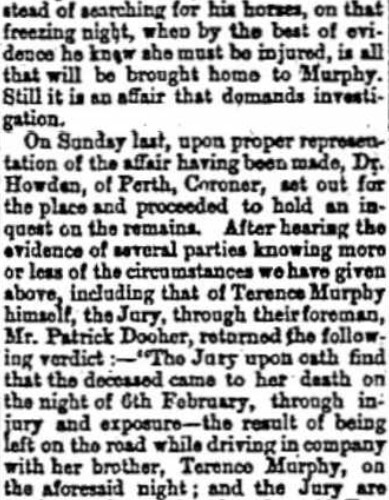
…further of the opinion that the said Terence Murphy was guilty of culpable neglect in not looking after the deceased, inasmuch as opportunity was afforded, and the evidence shown that he was not incapable through intoxication.”
On the Wednesday following, Coroner Howden issued a warrant for Murphy’s arrest, in order that the case might go before the Grand Jury at the approaching assizes, and, having been taken in charge by the constable, is now in jail awaiting the final disposal of the case.”

February 13, 1874, p. 2, 3, “The Perth Courier”
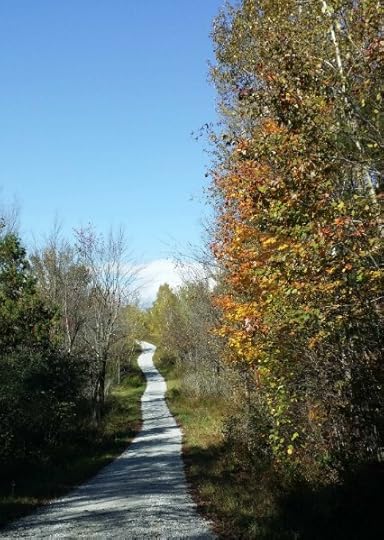
The hill where the tragedy occurred on the night of February 6, 1874
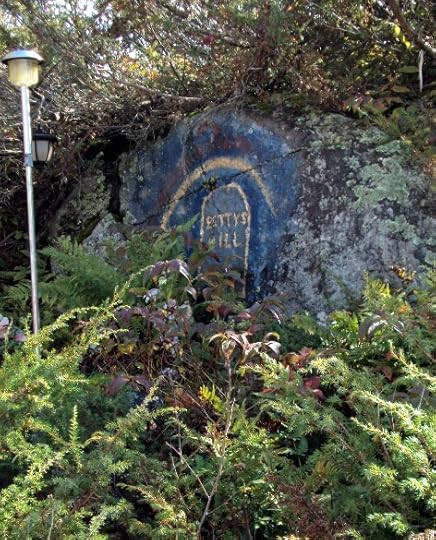
A tribute to Elizabeth, where she fell from the buggy and froze to death, on the McParland Road near Perth
Photo – Kay Ingalls, g-grandniece of Betsy Murphy
Third Tragedy
While we will never know for sure what happened on that fateful night when Elizabeth Murphy froze to death, we can be sure that her brother Terence Murphy, would have to live with the consequences of choices that were made. Did he assume that his sister, being young and healthy, in her early thirties, would have been fine left on her own while he chased after their team of horses? Did the amount of alcohol he’d consumed in Perth earlier that evening have any bearing on his decision-making abilities on that tragic evening?
What we may be sure of is that Terence Murphy would have felt the heavy weight of scorn from the people of Perth and the surrounding areas. Residents of small towns and rural communities tend to have very long memories, and even on his death, at age 83, there seemed to be little sympathy for Mr. Murphy as his demise was announced in a cold and detached statement on the front page of the local paper:
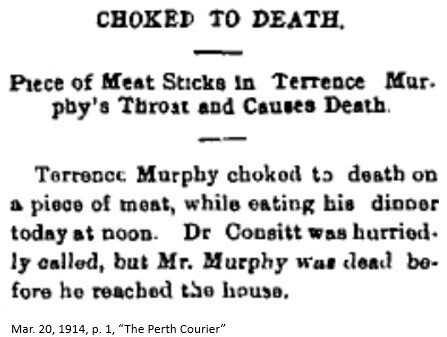
Comes in Threes
There is an old saying that, “Tragedy comes in threes”, and it seems fitting for the Murphy family, having been touched by three very dreadful and unusual deaths. Frank, the head of the family, father and husband, dying at sea on his way to Canada, Elizabeth freezing to death on a lonely snowy road, and Terence, choking to death on a piece of meat.
The tragedy of the Murphy family serves as a reminder to us that not all of the Lanark County Pioneer settlers thrived. Some of the settlers didn’t even survive the voyage from their homelands to set foot on the shores of Upper Canada. Some were not suited to farming and struggled with clearing their land and planting crops and eventually gave up and moved on. Although the economic situation during the potato famine in Ireland was grim, starting over again in a new place, so far from their families, may have caused many to have second thoughts about their choices.
The marker on McParland’s Road, the lone reminder of the hill where Elizabeth Murphy met her fate, still stands, as a silent memorial to that tragic night. It also serves to remind us of the Murphy family, who left County Armagh so long ago, in search of a better life. Like so many of our Lanark County pioneer families, they too were brave souls, leaving everyone and everything behind, their hearts filled with hopes and dreams of a better life for the generations that followed.

Arlene Stafford-Wilson
Honorary Life Member, Lanark County Genealogical Society
Member, Association of Professional Genealogists
Lanark County Pioneer Families Humanitarian Award 2023
Author of : “Lanark County Kitchen”, “Lanark County Christmas”, “Lanark County Comfort”, “Lanark County Collection”, “Lanark County Calling”, “Lanark County Classics”, “Lanark County Connections”, “Lanark County Calendar”, “Lanark County Chronicle”, “Lanark County Kid”, & “Recipes & Recollections”
February 9, 2024
Irish Winter Weddings

February – Shrovetide
Going back to the ancient times of the Gaelic Irish, winter weddings have always been the most popular, with the months of February and November ranking the highest. November was often chosen because it was long after the harvest was finished, and before the busy times of Advent. February was perhaps the most popular of all months, in the weeks leading up to Lent. Marriages were not performed during the fasting periods of either Lent or Advent, so the weeks before these religious observances became extremely popular for local churches. The wedding season in February was such a busy time for weddings it became known as “Shrovetide”.
Lucky Days
Certain days of the week were considered to be luckier than others to choose as a wedding day. Thursdays, Fridays, and Saturdays were all unlucky according to the ancient Irish ways. There was even an old Irish nursery rhyme about which was the best day to choose for your wedding:
“Monday for health, Tuesday for wealth,
Wednesday the best day of all,
Thursday for losses, Friday for crosses,
and Saturday no luck at all.”
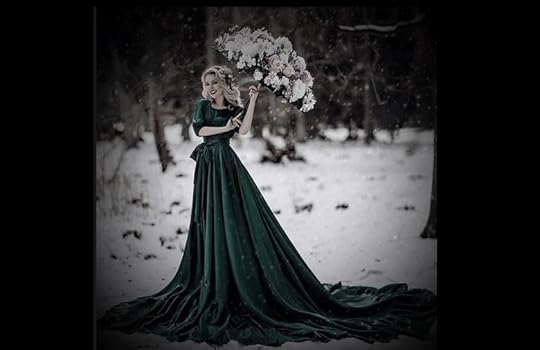
The Dress
In the old days, the Irish bride was forbidden to wear her dress before her wedding day. If she sewed the dress herself, she was not to put in the last few stitches. That job must be done by a friend or family member.
It was also bad luck for the bride to bake her own wedding cake. The cake must be baked by someone else, and not baked in the same house where the bride to be resides. The cake was to be brought to the place where the dinner would be held without the bride seeing it.
If a bride whistled a tune before putting on her wedding gown it was believed that the marriage was doomed.
Although green always was and still is a favourite colour for the Irish, it is not to be used for any items in the bride’s trousseau or worn on the honeymoon. Green is considered the colour of the fairies, and it might tempt the little folk to place a curse on the bride if she wears their colour on a special occasion. Wearing silk was also considered bad luck.
There is an old rhyme about choosing the colour of the gown:
“Married in white she has chosen all right,
Married in blue she’s sure to be true,
Married in yellow she’ll be ashamed of her fellow,
Married in grey she will go far away.”

Wedding Superstitions
Irish Wedding Superstitions:
If you happen to meet a man riding a horse on your way to the church on your wedding day, it’s considered lucky.
If you meet a red-haired woman on the morning of your wedding day, it’s considered unlucky. The only way to break the curse was to return home and start your trip again.
If a bride coughs during the wedding ceremony it was said that she wouldn’t make a good wife.
When they leave the church, couples must cross the threshold together, otherwise, whoever is first, will live longer. The same rule applies to entering their home for the first time after the wedding.
If a dish or glass is broken at the wedding dinner, then it was said the bride would break many during the marriage.
Strawboys

Strawboys have traditionally been associated with rural Irish weddings.
Dressed in straw costumes, the Strawboys would visit the house on the night of the wedding. Some arrived on horseback to the church before the wedding and the popularity of a couple was measured by how many Strawboys appeared.
The Strawboys would take the bride and groom out to dance. They danced and sang and created a merry atmosphere for the couple. It was considered bad luck to refuse the Strawboys, so normally the groomsman invited them in for a drink and some food.
Mead-Honey Wine
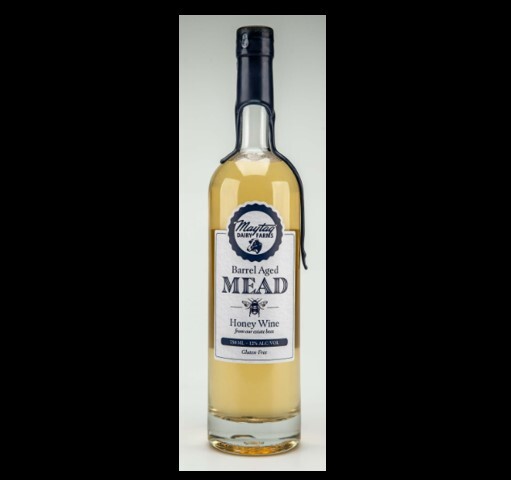
Mead, was a fertility drink for Irish newlyweds in the old times. It’s an alcoholic beverage made with honey, and some say is the origin of the word “honeymoon”. For most couples going away on a trip was reserved for the wealthy, but most could afford a bottle or two of mead for their early days as newlyweds.
Another common practice was that the married couple were not supposed to go to mass on the first Sunday after being married.
Hauling Home

It was considered bad luck in many parts of Ireland for a bride to return to her parents home before one month had passed. After thirty days, they held what was called a ‘Hauling Home’. At the hauling home, there would be a big dance and feast at her former home and she would gather up any of her possessions remaining there and bring them back to her new home with her husband. It was also a night where the Strawboys reappeared and took part in the merriment of the celebration.
Our Ancestors
While some of the old ways are not part of the modern Irish traditions, many of the ancient traditions or variations of them continue today. Our Irish ancestors brought some of these old customs with them when they came to Lanark County, and passed them down through the generations. When we look back at the origins of these practices, like scheduling the weddings around religious holidays, it’s interesting that the Irish also honoured their ancient Celtic beliefs in the fairies and the little people. From the old days of Shrovetide and the popularity of winter weddings, it continues to be a a lovely time of year for a wedding, in the weeks leading up to Lent, as the Earth prepares to welcome the warmer days of spring.
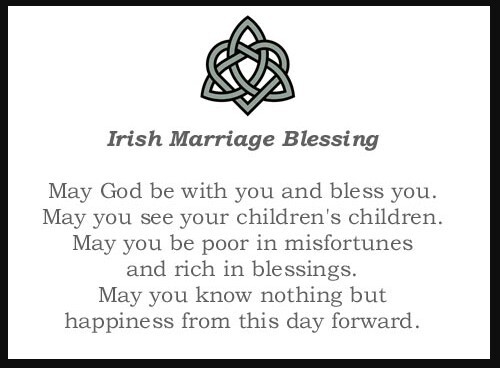
*
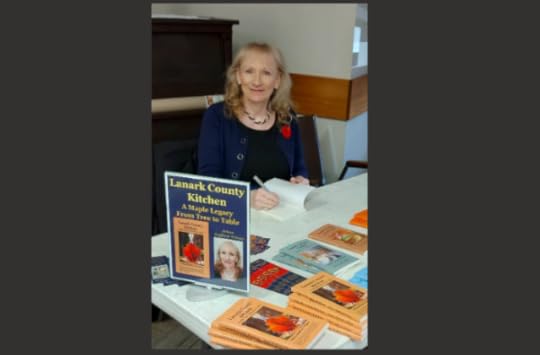
Arlene Stafford-Wilson
Honorary Life Member, Lanark County Genealogical Society
Member, Association of Professional Genealogists
Lanark County Pioneer Families Humanitarian Award 2023
Author of : “Lanark County Kitchen”, “Lanark County Christmas”, “Lanark County Comfort”, “Lanark County Collection”, “Lanark County Calling”, “Lanark County Classics”, “Lanark County Connections”, “Lanark County Calendar”, “Lanark County Chronicle”, “Lanark County Kid”, & “Recipes & Recollections”
February 8, 2024
Pakenham Five-Span Bridge
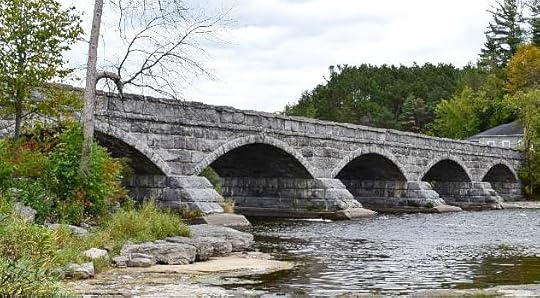
Pakenham
Five-Span Bridge
Original Bridge was Wooden
Like many other bridges in those days the original structure was built of wood, and the elements of heat and cold, freezing and thawing took their toll. The old wooden bridge needed frequent and costly repairs and it was decided that it would be a good time to construct a more durable bridge.
The Pakenham Township Counselors initially considered using iron which was popular at the time, but since the iron bridges were floored with wood they decided instead to build a stone bridge which would be longer lasting and more economical to repair. Plans were drawn for a five arch bridge, and a call for tenders was issued.

O’Toole and Keating of Ottawa
O’Toole and Keating of Ottawa won the bid, with an agreement to construct the bridge for $13,000. Ads were placed in local papers including the ‘Almonte Gazette’ and ‘The Perth Courier’ looking for bridge carpenters. They were offered an hourly wage of between $2.25 and $2.50, depending on experience, and a foremen would be hired at $3.00 per hour.
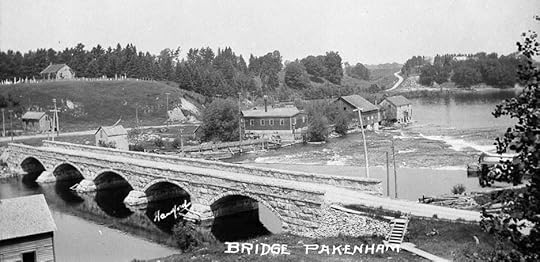
Building the Bridge
The work began on August 23, 1901 and was completed on October 23rd, an impressive seven weeks ahead of their proposed time limit. Seventy local men were employed. A steam-drill was used in the local quarry and a total of four sixty-foot mast derricks were used. It is believed that the quarry was located nearby.
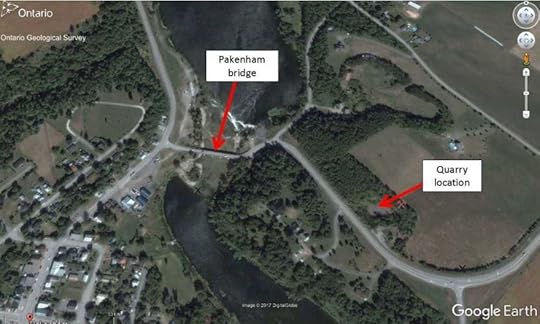
Limestone Quarry
The bridge was constructed from limestone rock. The largest limestone block in the bridge is about 9 feet long and about 2 and a half feet square, weighing over 5 tons. Limestone is an ideal material for this type of construction because it is resistant to heating and thawing, does not deteriorate when road salt is used, and is easier to mine than other similar types of rock.
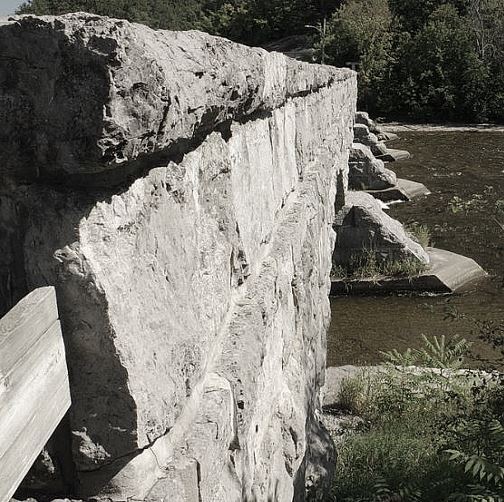
Massive limestone blocks cut from the local quarry
In the early 1900s there were an abundance of stone-cutters and mason who were skilled in cutting and shaping the limestone required for the bridge.
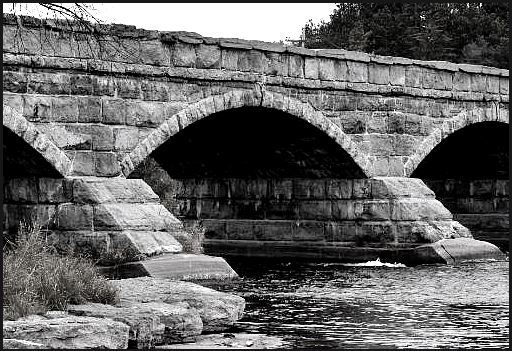
Five 40-Ft Arches
The finished bridge was 268 feet long with five forty-foot arches and was said to be the only one of its kind on the continent. James Connery, Township Clerk, John Smith – Reeve, John Shaw, Michael Connors, William Shaw and Adam Millar – Pakenham Township Councillors all played their part in the planning and execution of the new structure.

Mr. Robert Surtees of Ottawa prepared the blueprints and was the Engineer in charge of construction. William McDowall was the Inspector of the work, and Joseph Murphy of Arnprior was the book-keeper in charge of the budget while the work was in progress. George Quackenbush, local photographer, provided area newspapers with photos of the finished project.
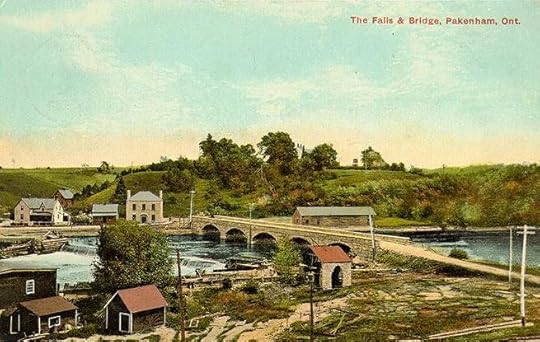
Postcard – 1910

Detail of the arch construction
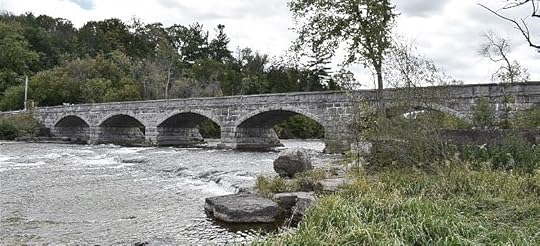
A view of the historic Pakenham bridge – the only one of its kind in Canada
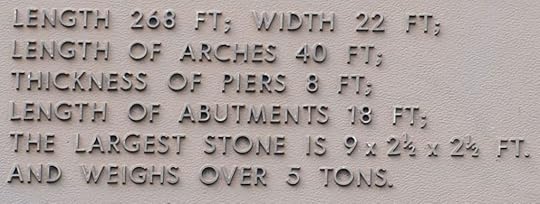
Details from the placque at the bridge site
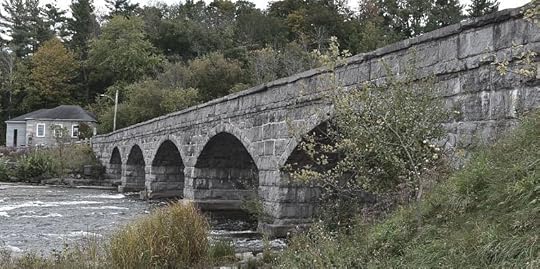
“Anyone who’s been to Pakenham will tell you that the awesome sight of this mighty river swelling and surging under the historic five-span bridge will remain forever etched in your memory. “
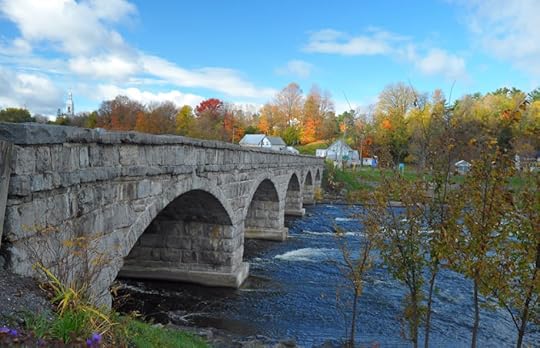
photo: Lanark County Tourism
Restoration in 1984

“The Almonte Gazette”


July 25, 1984, “Almonte Gazette”
The bridge was restored in 1984. The stones were carefully removed and cataloged, before being reinstated into their original position. A bed of reinforced concrete was set underneath the stones for additional strength.
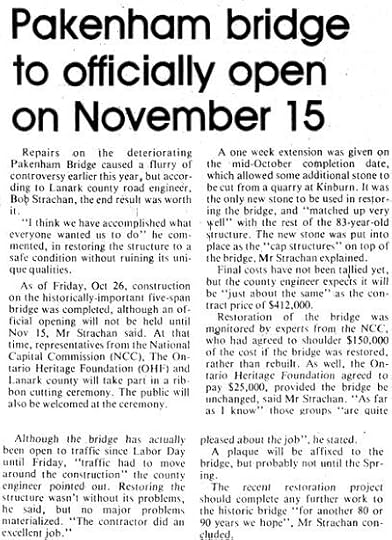
Oct. 31, 1984, “Almonte Gazette”
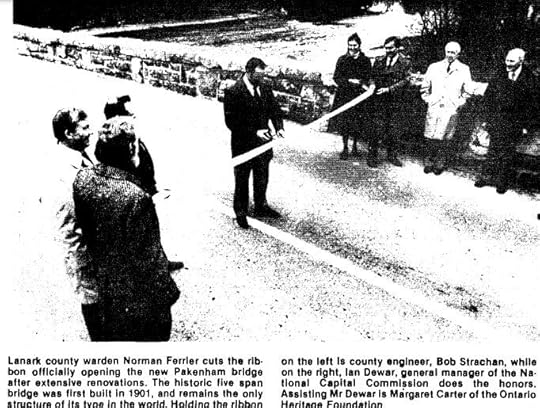
Nov. 21, 1984, p. 1 “Almonte Gazette”
Total Cost
The cost to build the bridge in 1901 was $15,400, including the construction of a temporary bridge for use during the project.
The 1984 restoration of the bridge cost $380,000. Of this, $150,000 was paid by the NCC (National Capital Commission, and $25,000 by the Ontario Heritage Foundation.
2007 Flag
Pakenham amalgamated with Almonte and Ramsay to form Mississippi Mills in 1998. The bridge was chosen as one of the principal symbols for their flag in 2007.
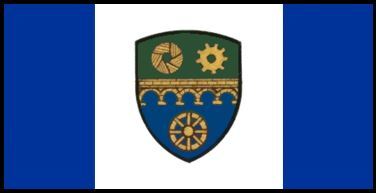
In the Movies
The 2020 Christmas movie, “Fatman”, (starring Mel Gibson, Walton Goggins and Marianne Jean-Baptiste) features a driving scene filmed on the Pakenham bridge.
Seven Wonders of Lanark County
Designated as one of the ‘Seven Wonders of Lanark County’, the Pakenham Bridge will continue to delight visitors and residents alike, with its breathtaking vistas, and rich history.
The bridge is located at 4916 Kinburn Side Road.
For a story set in Pakenham and the nearby Five-Span bridge:
“Lanark County Classics: A Treasury of Tales from Another Time – featuring the story, “Perils in Pakenham” Story features many local family names.

.

Arlene Stafford-Wilson
Member, Association of Professional Genealogists
Lanark County Pioneer Families Humanitarian Award
Honorary Life Member, Lanark County Genealogical Society
Author of : “Lanark County Christmas”, “Lanark County Comfort”, “Lanark County Collection”, “Lanark County Calling”, “Lanark County Classics”, “Lanark County Connections”, “Lanark County Calendar”, “Lanark County Chronicle”, “Lanark County Kid”, & “Recipes & Recollections”
and “Lanark County Kitchen: A Maple Legacy from Tree to Table”
February 2, 2024
Groundhog Blues in Lanark County

January always seemed like the longest month on the calendar. It was still cold and dark when February arrived, and there were so many months ahead before we could ride our bikes to DeWitt’s Corners, or Christie Lake.
Each year, we waited patiently for Groundhog Day. Would he see his shadow? Would there be an early spring, or would there be another two months at least of these cold, grey days?
Punxsutawney Phil had predicted the onset of spring since 1890 in Pennsylvania, and his Canadian counterpart Wiarton Willie began his annual forecast in the 1950s. At our house we listened closely to both forecasts, hoping that at least one of these rodents would offer some hope of an early spring.
So, we had two possible groundhog predictions, and two different radio stations. There was CJET in Smiths Falls, and Mother would often tune in and listen to Hal Botham after we’d left for school, while she did her ironing. CFRA was her usual early morning station and we’d often hear Ken ‘General’ Grant shouting, “Forward Ho!” as we ate our puffed wheat, before walking down the lane to wait for the school bus.
I could tell that Mother was also growing weary of the long, cold days of winter and if the ‘General’ didn’t report the prediction she wanted to hear then she’d likely turn the dial to CJET hoping that Hal Botham would have another version of the groundhog’s forecast. If it was cloudy, and the groundhog didn’t see his shadow, we’d have an early spring. By the first week of February we didn’t want to hear any other forecast. Six more weeks of winter would be enough to bear, without the possibility of the season being any longer!
When I came downstairs for breakfast that Groundhog Day morning so long ago, Mother had already set up the old ironing board and was busy ironing a linen tea-towel. I asked her if she’d heard the groundhog’s prediction yet, and she didn’t look up, but continued to iron. “It’s just a myth, just folklore”, she said, and she folded the tea towel neatly, and started on the next one.

“So, he saw his shadow?” I asked. “Yes they both did.” she responded somberly, still not looking up from her work, and folded the next tea-towel.
I sat quietly at the old kitchen table, ate my bowl of puffed wheat, drank my orange juice, and took my cod liver oil capsule without even being asked. Six more weeks would mean spring starting sometime in the middle of March…….or would it be even longer?
I finished my breakfast, put my dishes in the old porcelain sink, pulled on my boots and coat, grabbed my wool hat, mitts and lunch pail, and headed out the door.

As I trudged down the long, snowy lane-way to the Third Line, I felt defeated. It was sad how a couple of groundhogs that we didn’t even know could make Mother and I feel so depressed. I didn’t even understand how they could have seen their shadows that morning, because it wasn’t sunny outside at all. I couldn’t see my own shadow, and that meant that our local groundhogs wouldn’t be able to see theirs either.

I didn’t really know where Wiarton was located in Ontario, and didn’t have a clue about Pennsylvania, but I was sure that none of the groundhogs in Lanark County saw their shadows on that cloudy, grey morning in February. Maybe the other groundhogs were wrong! Maybe there would be an early spring after all! Maybe the snow would be gone soon, and I could ride my bike up to Christie Lake again. I had to stay positive. I had to keep hoping. I had to…
* * * * * * *
(an excerpt from ‘Lanark County Calendar: Four Seasons on the Third Line”
ISBN 978-0-9877026-3-0)
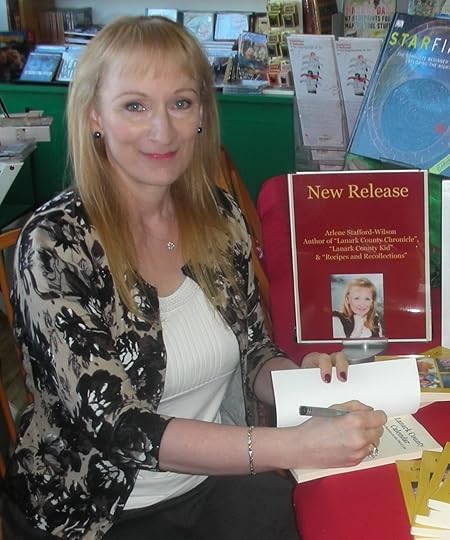
Arlene Stafford-Wilson
Member, Association of Professional GenealogistsHonorary Life Member, Lanark County Genealogical SocietyLanark County Pioneer Families Humanitarian AwardAuthor of : “Lanark County Christmas”, “Lanark County Comfort”, “Lanark County Collection”, “Lanark County Calling”, “Lanark County Classics”, “Lanark County Connections”, “Lanark County Calendar”, “Lanark County Chronicle”, “Lanark County Kid”, & “Recipes & Recollections”and “Lanark County Kitchen: A Maple Legacy from Tree to Table”January 25, 2024
You Might Be Scottish if…..

In 1820 and 1821, a thousands of Scottish settlers arrived from the Glasgow area and settled in the Dalhousie, Lanark, North Sherbrooke, and Ramsay townships in Lanark County. They brought their traditions and customs with them from the old country, like the celebration of their famous poet, Robbie Burns.
January 25thOn January 25th our thoughts turn to all things Scottish as we prepare to celebrate the birthday of Robbie Burns, perhaps one of the most famous poets born and bred in Scotland. Although Robbie died at the tender age of 37, he left a legacy of poetry unmatched, and has become one of Scotland’s most beloved characters.
Today, there are people of Scottish descent scattered all over the world, and though they may be far from the land of their ancestors, they still share the traits passed down from those who came before.
Do you have any Scottish blood flowing through your veins?
Here are the top 20 ways to tell if you are Scottish:You might be Scottish if……1. You could swear before you could count.
2. You’ll wait at a store counter for a nickel of change.
3. You still enjoy watching ‘Braveheart’ even though it’s more Hollywood than historical.
4. You prefer to measure things in feet, pounds, and gallons.
5. Your eyes are a lovely shade of blue or green or a light hazel-brown
6. Even though you know what haggis is made with…you still eat it.
7. Your eyes tear up at the sound of bagpipes playing ‘Amazing Grace’.
8. Your speech becomes more colourful after a wee nip or two
9. If someone insults those dear to you, they’ve may have a fight on their hands
10. You’ve got lovely skin, and pleasant facial features
11. You’re a hard worker, and always make sure that every job is done well
12. You’ve likely remained loyal to the same sports team for years, even if they always lose
13. You’re strong willed, with a steely determination.
14. You have a stubborn streak and have been known to hold a grudge
15. You would dive into the street to retrieve a penny during a parade and risk death and injury.
16. You re-use your plastic bags and keep them in a drawer.
17. You’ve got a wonderful sense of humour and enjoy a joke or two
18. You stop talking and listen when bagpipes are playing.
19. You are fiercely loyal to family and friends and extremely proud of your heritage
20. Above all, you possess a strong sense of honour, and always keep your word.
……….
Can you namethese famous Scots?(answers at the bottom of the page)






‘Auld Lang Syne’, was written by the iconic Scottish poet Robbie Burns, and on January 25th each year Scots all over the world celebrate the day he was born in 1759. Many Scottish folk attend what is known as ‘Burns Night’ where they will feast on a traditional meal of the infamous ‘haggis’.
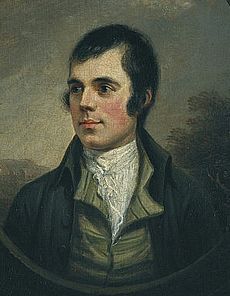
In honour of Robbie Burns here is a traditional Scottish recipe for Haggis:
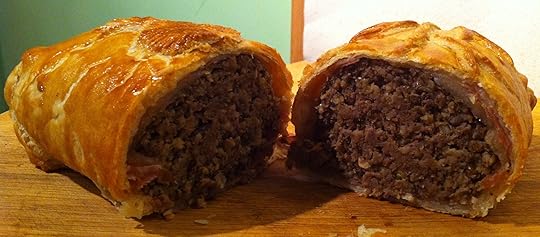
1 set of sheep’s heart, lungs and liver (cleaned by a butcher)
One beef bung (intestine)
3 c finely chopped suet
1 c medium ground oatmeal
2 medium onions, finely chopped
1 c beef stock
1 tsp salt
½ tsp pepper
1 tsp nutmeg
½ tsp mace
Method:
Trim off fat and sinew from the sheep’s intestine and, discard the windpipe.
Place in a large pan, cover with water and bring to a boil
Reduce heat, simmer for 1 hour until tender and cool
Chop the meat into fine pieces and combine in a large bowl with the suet, oatmeal, finely onions, beef stock, salt, pepper, nutmeg and mace
Mix well.
Stuff the meat and spices mixture into the beef ‘bung’ which should be over half full, then press out the air and tie the open ends tightly with string
Leave room to expand or it may burst while cooking
Place in a pot and cover with water, and bring to a boil. Reduce heat and simmer, covered, for 3 hours.
Serve hot with “champit tatties and bashit neeps” (mashed/creamed potato and turnip).
For added flavour, you can add some nutmeg to the potatoes and allspice to the turnip. Some people like to pour a little whisky over their haggis – Drambuie may be used as well.
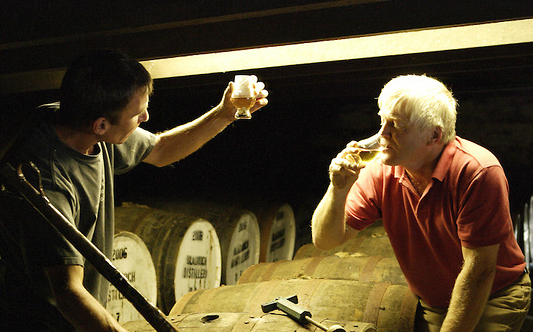
Whether you are planning to attend a ‘Burns Night’ celebration this January 25th, or just having a small gathering at your home, don’t forget to recite the traditional Selkirk Grace before enjoying your haggis along with a wee dram of your favourite Scotch! Happy Robbie Burns Day! Och Aye!
Selkirk Grace
“Some hae meat and canna eat,
and some wad eat that want it,
but we hae meat and we can eat,
and sae the Lord be thankit.”
………
Answers – Scottish Celebrities : 1. Annie Lennox, 2. Sean Connery, 3. Isla Fisher, 4. Ewan McGregor, 5. Sheena Easton, 6. Gerard Butler
………
Many of the pioneer settlers in Lanark County, Ontario, Canada came from Scotland.
For more information on researching your Scottish ancestors who settled in Eastern Ontario:
Lanark County Genealogical Society
………
Scottish Genealogical Society, Edinburgh, Scotland
……….
Scotland – Births & Baptisms 1564-1950
……….
National Library of Scotland – Genealogical Research
……….
………..
(This post is dedicated to the memory of James ‘Jim’ Gebbie, my husband Kevin’s uncle, who passed away in 2013 in his native Scotland. Jim was a kind soul, and a fine gentleman, and I had the privilege of spending some time with him on his visit to Canada in the summer of 2011. He shared many of his stories with us, of life as a boy growing up in Hamilton, Lanarkshire, Scotland. We hope that wherever Jim is now, they will be serving up his wee glass of scotch that he enjoyed so much before dinner each evening. Rest in peace Jim.)………

Arlene Stafford-Wilson
Member, Association of Professional GenealogistsHonorary Life Member, Lanark County Genealogical SocietyLanark County Pioneer Families Humanitarian AwardAuthor of : “Lanark County Christmas”, “Lanark County Comfort”, “Lanark County Collection”, “Lanark County Calling”, “Lanark County Classics”, “Lanark County Connections”, “Lanark County Calendar”, “Lanark County Chronicle”, “Lanark County Kid”, & “Recipes & Recollections”and “Lanark County Kitchen: A Maple Legacy from Tree to Table”

